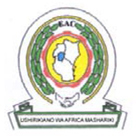
In order to promote public education and public safety, equal justice for all, a better informed citizenry, the rule of law, world trade and world peace, this legal document is hereby made available on a noncommercial basis, as it is the right of all humans to know and speak the laws that govern them.

EAS 385:2005
ICS 01.040.61
EAST AFRICAN COMMUNITY
© EAC 2005
First Edition 2005
iDevelopment of the East African Standards has been necessitated by the need for harmonizing requirements governing quality of products and services in East Africa. It is envisaged that through harmonized standardization, trade barriers which are encountered when goods and services are exchanged within the Community will be removed.
In order to achieve this objective, the Partner States in the Community through their National Bureaux of Standards, have established an East African Standards Committee.
The Committee is composed of representatives of the National Standards Bodies in Partner States, together with the representatives from the private sectors and consumer organizations. Draft East African Standards are circulated to stakeholders through the National Standards Bodies in the Partner States. The comments received are discussed and incorporated before finalization of standards, in accordance with the procedures of the Community.
East African Standards are subject to review, to keep pace with technological advances. Users of the East African Standards are therefore expected to ensure that they always have the latest versions of the standards they are implementing.
© East African Community 2005 — All rights reserved*
East African Community
P O Box 1096
Arusha
Tanzania
Tel: 255 27 2504253/8
Fax: 255-27-2504481/2504255
E-Mail: eac@eachq.org
Web: www.eac.int
* © 2005 EAC — All rights of exploitation in any form and by any means reserved worldwide for EAC Partner States’ NSBs.
iiGlossary of terms relating to footwear
This East African Standard gives the glossary of terms relating to footwear for use in the footwear industry.
Abrading
The roughening up of the over margin of the lasted upper.
Abrasion Resistance
The ability of a footwear material to withstand wear due to abrasion
Abrasives
Materials, such as emery paper, emery cloth, red flint and carborundum used for scouring or buffing soles, heels, etc, of footwear. Roughness of the surface of the abrasives is denoted by grits.
Accelerator
A substance added to a rubber mix to accelerate the process of vulcanisation and in other ways to improve the bottom of footwear.
Acme Backer
Plain weave cotton cloth coated on one side with thermoplastic gutta percha or with rubber and wax used for backing uppers.
Acrobatic Shoe
Shoe made with extra light uppers and soles for acrobatic works.
Adhesion
A molecular attraction exerted between the surfaces of bodies in contact.
Ammunition Boots
Ankle-high sturdy boots of Derby type with six eyelets, full tongue made by riveted, screwed and stitched method for heavy duty purposes. These are also known as Ankle Boots.
Ankle Bone
See ‘Astragalus Bone’.
Ankle Boots
See ‘Ammunition Boots’.
Ankle-Girth Measure
The girth measurement of the leg joint above the ankle.
Anatomic heel
Inner side extended forward on the shape of “S”.
Anterior Arch
The arch of the foot between the phalanges and the metatarsal bone which extends across the ball of the foot from the outside edge of the first metatarsal to the outside edge of the fifth metatarsal. This is also known as ‘Metatarsal Arch’.
Antique Finish or Dressing
A dressing applied to an upper and immediately removed except in edges and crevices so producing the appearance of old and well cared for leather.
Applique
A strip or design fixed on to a footwear for decorative purpose.
Apres Ski
A man’s or woman’s fur-lined and water proof boot.
Apron Front Shoe
A combination of the basic Derby and Moccasin designs. The difference lies in the front (that is, in the vamp), which has a separate apron laid on or underlaid and which is at Arch times one-piece with the tongue. The design is also known as the ‘Ski Design’.
Arch
The long framework of the foot extending from the heel to the toes.
Archbrace
A bandage of webbing or leather designed to support arch.
Arch of the Foot
A bridge made up by the bones of the foot, mainly to support the body weight
Arch spring
The upward curve of the arch of the last or footwear.
Arch support
Stiffening effect given on the inside of a footwear to give support to the arch of the foot. Wide steel shanks ribbed double or triple lengthwise and ribbed across as well are provided to support the arch in the high class shoes, ammunition boots and corrective footwear to give stiffening effect.
Arctic Boots
A type of Over boot originally made from buffalo hide with grain side in and with buckles to keep feet dry and comfortable in cold and wet climate. Subsequently rubber has been used for the manufacture of arctic Over boots without any change in the basic pattern.
Artificial Grain
A grain appearance given to a flesh split by pigment with or without embossing on footwear upper.
Assembling tack
A tack having a round parallel shank made from wire with a square pyramid point, used in the assembling operation. This type of tack is driven through the upper material at the top of the back seam. The head of the tack is very similar to that of the welted tack. The fine point and shank are provided to leave a mark as small as possible on, the upper.
Assembly Room
Area in which the closed uppers, the reinforcing components, the bottom components and the lasts are held and matched up into sets for the insisting room as required.
Assembling Upper
Inserting of the prepared components, such as toe-puff, stiffener and side lining, in the respective positions. The term also refers to the tacking of the upper to the last at the counter point prior to being lasted.
Astragalus Bone
A bone of the human foot located in the tarsus group of bones. Also known as ‘Ankle Bone’ or ‘Talus Bone’.
Athlete’s Foot
A kind of foot infection due to ringworm, which softens and peels the skin between the toes, and on the sole of the foot causing irritation.
Attaching
Attachment of the upper and bottom parts using one of the various methods of attachments.
Awl
A sharp-pointed tool with a small round handle, generally known as `Pricking Awl’ which is used by the upper leather clickers to make the prick holes for the convenience of the upper closer.
or
A sharp flat pointed tool used in the outsole stitching machine, similar in shape to the outsole stitching machine needle and which has no hook for taking up the thread. The purpose of this awl is first to pierce the outsole and make it easier for the sewing needle to go through the outsole while sewing.
Backer
A fabric material used to give reinforcement and plumpness in order to reduce stretch in thin leathers like glaze kid, calf, lizard etc.
Backing
Laminating a piece of fabric to leather or other components of a footwear by adhesive.
Backing cloth
Cloth usually of thin and loose character treated with a solution of gutta percha pasted on the outside section of the upper to increase its strength and durability.
Back Splitting
Reduction of sole substance at the heel, shat and waist, mainly done for Louis Heel construction.
Back Stay
Material like taffeta used for reinforcement at the top of the back seam and down the facing. A small oblong stay piece cut out of the material is held in position while stitching the lining with the upper.
Back Strap
Strap of leather which joins the two quarters at the back of the boot or shoe to give added strength to the back seam.
Back Tacking
An operation in upper assembly for taking the lower and of the upper on the insole, before feeding it to the machine for pulling over by machine.
Bagged Edge
A method of joining a finishing of the quarter top edge all round the ankle so that the seam joining the lining with the quarters is about 5 mm below the folded edge of the quarter.
Bal
Front laced footwear in which the quarters meet at the vamp unstitched over the quarters at the front of the throat.
Ballerina
A low cut, light weight, practically flat-heeled, new-cut type shoe used by women and constructed by direct method of attachment. It has a similarity with ballet dance shoes.
Ballet shoe
A type of shoe used for dancing made of cloth (sometimes of satin) with heavily blocked toes. They are generally made by the turn shoe method and are very light and flexible.
Ball girth measurement
The circumference of the foot around the middle of the big and small toe joints.
Ball line
A line drawn across the widest portion of a foot or last.
Ball point
A point where the first metatarsal bone meets the phalanges or big toe. This joint is prominently visible on the inside of the foot just adjacent to the big toe.
Ball point of last
A point on the last where pitch line meets the baseline.
Ball position
See ‘inside foot joint position’
Balmoral
A type of gents’ boots or shoes having a closed front-laced ankle. It is characterized by the vamp wings extended to either side, to form a golosh.
Bar shoes
A slipper type of shoes with a bar running over the instep from the inside water to outside water where it is either fastened with a button or a buckle.
Baseball shoes
Pumps shoes usually machine sewn, light and heelless with special sharp metallic reinforcement on the heel and ball of the shoes
Base of bone
The lower end of the oscalcis (or calcaneum) bone which is also known as heel bone. This is the largest and strongest bone in the tarsus group and is used mainly for transmitting the weight of the body to the ground.
Basic cutting area
The area which include pattern area and the unavoidable waste. The pattern area is the space required by the patterns individually. The area between the pattern which cannot be avoided when patterns are laid out together is termed as unavoidable waste.
Basic Shoe Designs
There are sixteen recognized basic shoe designs, namely, (a)Balmoral, (b) Blucher/Derby, (c) Boot, (d) Brogue, (e) D’orsay, (f) Ghellic, (g) Gore, (h) Jodhpur, (j) Moccasin/Casual, (k) Monk, (m) Mule, (n) Oxford (p) Pump, (q) Sandal, (r) Fringe/Shawl, and (s) Strap (see annex A).
Basic Shoe Types
Footwear are universally classified mainly into four types, namely, (a) Sandal, (b) Moccasin, (c) Moccasin and Sandal combination, and (d) Proper shoe (a modified moccasin and sandal).
Basket Weave
A style of weave done in leather upper.
Beach sandals
Simple sandals for seaside used usually of rubber or plastic.
Beaded Edge
Forming a neat edge by turning inside the unskived edge of a section of the upper.
Beading
The turning in of a skived or unskived edge of an upper section. Sometimes the skived edge is turned over a cotton tape to give a pleasing appearance and more strength at the edges.
Bead on Sole Edge
The tiny ridge or bead which will be found on finished sole edge of shoe either on one or both sides. The ridges on the welt and on the sole edges are respectively know as welt bead and sole bead.
Bedding Sole
Fixing sole in its proper position so as to conform to the bottom shape of the last in mellow condition.
Bed Lasting
An operation by which upper at the toe and seat is wiped to proper position on the insole and kept in position by cement, wire or tacks.
Beech Wood
A hard slightly reddish-brown wood obtained from Fugus sylvatica L., fam. Fegacca suitable for last making. This wood does not split and is free from knots.
Beeswax
An insect wax prepared from the honey combs of either wild or domesticated bees after the removal of honey.
Bellows tongue
A broad folding tongue stitched to the quarter at each side.
Belly
The underside of a hide or skin between fore and hind legs.
Belly size
Shoe sizes that are commonly in demand.
Benching
Operation of giving final faking and fiddling to the shoes, after having passed through all the finishing operations, for any slight imperfection either in upper or bottom.
Bespoke Shoes
Shoes made to order.
Bevelling
Reducing the substance of certain components of the shoe bottom by skiving, such as sole waist bevelling, insole seat bevelling, welt bevelling, piece sole bevelling and graft sole bevelling.
Bevel Waist
The sole edge of any welted shoe is bevelled at the waist to give an appearance of a single sole or a lighter sole. The outersole channel is placed further away from the edge so that the levelling operation may not damage the stitches.
Bias Binding
Fabric binding cut diagonally as a continuous 45° spiral from a circular woven cloth. The bias or diagonal structure facilities binding on all types of curves.
Bifurcated heel pins
Round parallel shank pins used for attaching heels, made from screw wire which are without heads or points, but whose ends are bifurcated to increase their holding power.
Binding
Bit knife
A knife used to even up the inside edge of welt and middle sole in order to get the edge uniform in substance. The cutting part of this knife is a continuation of the tool itself.
Blake sewn construction
A method of construction in which there is direct attachment of upper to sole. In this method, the upper is lasted to insole with tacks, staple or thread and the sole is then attached by vertical chain or by locks stitches. In case of hand method the attachment is made by lock stitches only.
Blind eyelets
Eyelets with their surface
Blind eyeleting
A method of setting eyelets to the shoe upper and such a way that the eyelet ends show on the outside but the barrels do not penetrate the lining; the clenching being done on the reverse side of the upper material or on a reinforcing tape. The lining covers the clenched barrel and so protects the socks or stockings.
Bending sole
The portion in which soles are temporarily attached with the help of nails and are driven through the last margin of upper and insole. They do not penetrate the sole right through and thus give an appearance of blind attachment.
Blocked toe
The toe of the footwear without any opening at the toe.
Blocked fitting upper
A method of fitting the upper, in which sections of the upper are placed over a wooden block, similar in shape to the last and positioned to assume a shape relative to the final shape of the shoe.
Block forme
A method of forme cutting a hole cut paper is first folded to the last and then adhesive strips of paper are pasted all over the last in a systematic manner. The folds are removed gradually while doing so. Finally, this is cut along the feather edge all around and the blocked top position, known as blocked forma, is separated from the last.
Block insole
See ‘insole blocking’.
Blocked
Leather preshaped by the moulding operation.
Blucher Bal
A modified blucher shoe in which the vamp is stitched overlapping the quarter.
Blucher Shoe
Shoe patterned after a half boot that is an open lace shoe (derby type).
Boot
A name given to any shoe reaching above the ankle or still higher.
Bootee
A type of boot with warm lining, usually worn by women and children in cold weather. A knitted fabric foot covering for infants is also known as bootee.
Bottom
Bottom face of a footwear sole which extends from toe to heel breast.
Bootline
A short casual boot that hits the ankle and usually is worn with stretched paints.
Bottom filler
The material used to fill up the cavity formed by the lasted margin of the upper and the insole.
Bottom finishing shoe
The finishing room operations, such as trimming, scouring, inking, and polishing, in order to improve the appearance of the finished shoe.
Bottoming
The attachment of the lasted footwear to the sole by direct or indirect method of construction.
Bottom levelling
Levelling either on machine under high pressure or by hand using sleeking sticks to give the bottom a good shape and remove all bumpiness after the soles are stitched and channel-closed.
Bottom manipulation
Clicking or cutting of bottom components.
Bottom stock or rough stuff
A collective name given to various bottom components used in footwear construction, such as outer sole, insole, welt, heel lift, and heel top pieces.
Bow
A decorative accessory for women’s shoes sometimes on the vamp or sometimes at the ends of the laces.
Boxing
The final operation in which the shoes are packed in boxes in pairs, ready to go out of factory.
Box Toe
A stiffener used to maintain and reinforce the shape of the shoe to, preserve the toe-room allowed within the shoe, and to protect the wearer’s toes from blows. Rigid box toes are made of leather, thermoplastic resin-impregnated fibre, solvent softened plastic-impregnated fibre, and water softened starch-impregnated buck ram. Flexible box toes are made of thermoplastic cork combination with fabric backing, and plastic laminates placed between fabric sheets. Soft box toes are made of rubberized felt or fabric. Metal box toss are used in some safety footwears.
Boxer Top
Used to describe elastic, plain or covered with leather or synthetic when used around collar or a shoe or a boot.
Bracing
Sewing the upper temporarily to the insole shoulder, before the lasting rivets are removed to hold the upper in position firmly for welt sewing.
Braiding
The production of ribbon-like or cord-like textures by inter-lacing of threads or narrow strips of leather for decorative purposes. Each strand in braid follows a path of its own either from side to side {for flat braid) or round and round {for tabular braid).
Brannock
A foot size measuring device with a sliding gauge to measure fitting.
Break
The wrinkling of leather in the fore part of the shoes caused by flexing in walking.
Breasting
Trimming or cutting down the front or the breast of the heel with either a power-driven, suitably shaped descending knife or by hand knife.
Breast scouring of heel
Smoothening the breast of the heel by scouring.
Brocades
Made of cotton, silk or rayon of metallic covering, with additional silk weft threads of gold or silver included to give a pattern usually backed with cotton cloth for fancy type of footwear.
Bregan
A heavy work shoe with pegged or nail sole construction.
Brogue
A balmoral type of low cut laced heavy soled shoe, sometimes trimmed with pinking perforations and stitching.
Brogue shoe
A balmorai type of shoe with perforations and gimpings on the upper.
Buckles
A kind of metallic fitting used in footwear for fastening straps and for decorating purposes.
Buckram
A stiff fabric laminated or otherwise used for backing light upper leathers especially at the flesh sides.
Buffing
Removing a thin layer from the grain side of the sole or insole by use of abrasive to give it a final look or to allow the penetration of colour and prevent cracking.
Built heel
Complete heel composed of lifts, special lifts, top piece, slugged, compressed and breasted, and made to required height.
Bunching
Term applied to action of the bottom filling shifting from its own place and bunching or depositing at different places forming humps and causing annoyance to the wearer.
Bunion
A inflammatory swelling of the borsa over the metatarso-phalangeal joint of the great toe caused by undue pressure and friction being brought upon that particular portion of the foot.
Bunking
Putting a fancy pattern on the sole edge of the shoe bottom by means of an adjustable heated tool which usually runs over the channel to hide any fault in channelling or channels laying and to improve the appearance of the footwear bottom.
Bunking wheel
A appliance having a wheel used for giving embossed decoration on the edge of a gummed or dumped finished sole. A patterned impression is produced in a series of short straight strokes or any other design.
Burned sole
When leather is heated above 110°C, it becomes brittle and breaks off.
Burnished edge, upper
The treatment of a specially skived edge given to cheap quality footwear by a special machine in which the fibres on the edges are burnt to give a slightly curled appearance and to give a false folded edge.
Burnishing
Polishing to secure a bright glossy finish.
Burnishing heels
The application and impregnation of wax into the heel by the use of heated implements.
Butted seam
Seam produced by joining two components, edge to edge by zig-zag seam.
Butt jointed sole
A three quarter sole with tonguing at the heel end, used with fitted heels, the semi louis or Cuban type.
Buttons
Fittings used for fastening and for decorative purposes.
Cack
A small soled shoe without heel and loin soft upper. It’s of size 1-5 (KS 1632) and for infants.
Calcaneum
The largest bone in human foot and one of the bones of the tarsus group which situated at a distance of the foot length measured from the back. The body weight is transmitted to ground to a large extent through this bone.
California slip-lasted construction
In this method the upper is stitched on to the sole lining which in turn is stitched to the heel and platform cover. A last is then forced into cavity so formed. The wedge heel and platform are stuck to the soft lining into position and their edges are covered. Finally, the sole is attached by cementing.
Calf measurement
Girth measurement at the calf of the leg.
California process
See California slip-lasted construction.
Calking machine
An appliance used for to depressing to shape the inner sole to make it conform to shape.
Callous
A spot of thickened and toughened skin formed as a result of pressure and friction on the sole, heel and side of the foot, later develops into a corn.
Canvas boots
Boots of canvas upper and rubber bottom in which unvulcanized rubber sole is directly attached with the upper and then vulcanized.
Canvas lining
A plain weave heavy cotton cloth, used for lining of heavy shoes, usually combed and waterproofed.
Canvas shoes
Shoes of canvas upper and rubber bottom in which the unvulcanized rubber sole is directly attached to the upper by vulcanizing.
Cap
An attached or imitation cap with a central peak and curved on either side, sometimes perforated.
Carriage boot
A loosely made boot of leather or fabric often fur trimmed and intended to be worn in winter by women being clipped over the ordinary shoes or slippers. Commonly worn over evening slippers.
Carnauba wax
A hard, pale yellow or brown commercial wax. obtained as an exudation from leaves of the wax palm Copernicia cerifera mart, fam. Palmae,. Due to its high melting point long lasting gloss it is generally used for footwear polishes in conjunction with other waxes.
Cartons
Standard sized cardboard boxes in which the footwear are packed before being despatched from the factory.
Caster Shape
Shape of outer soles and insoles so designed as to contain within their area sufficient space to enable other shapes to be cut from them.
Casual footwear
Any footwear of light construction, suitable for informal or casual wear which is easy to slip on without any fastening device.
Cavalier boot
Men’s boot made of soft upper stock, ankle high usually with two inch folded collar, crimped or moulded front.
Celastic Toe-puff
A hard to-puff made of raised cotton cloth, either single or double, impregnated with cellulose and available either in sheet form or in pieces out to the shape of the puff. Softening of the toe-puff in solvent before insertion and quick lasting of the shoe after insertion is necessary.
Celluloid eyelets
Eyelets having brass as their base with their head covered with a heavy coating of viscous celluloid solution.
Celluloid toe-puff
Layers of fabric impregnated with cellulose solution kept in moist condition in air-tight containers. This puff requires no skiving along the cap-edge, the effect of skiving being produced by stepping the layers of fabrics when they are stuck together. Softening of the puff is not required before insertion but quick lasting is essential.
Cement
A general term applied to adhesive materials in footwear industry.
Cementing
Application of cement on roughed or scoured portion of the footwear by brush or machine.
Cemented construction
A method of footwear construction, in which the upper may be secured to the insole with threads, tacks, staples or cements (adhesive material) and then the sole is attached to upper and in sole by cement under pressure.
Cemented shoes
Shoes manufactured by cemented method.
Cement lasting
Lasting of footwear uppers using adhesives.
Chain stitch
A type of stitch, made by one thread only. The view resembles lock stitches but the under side give the appearance of a chain. It is characterized by the fact that the entire thread may be pulled when one stitch is cut or broken.
Channelling
The production of a groove or channel in the leather in which the stitching is laid while attaching the soles and other parts.
Channelling insole
In the welted insoles two parallel hinged panels are cut or a single panel is cut on the flesh side between leather substance either all round or from one side of the drive of the heel to the other round the edge to enable welt sewing.
A single opening channel is also cut on the grain side or the in sole for single sole construction to enable the stitches to be embedded in the channel.
Channel laying
Closing the channel lip after sole stitching by applying cement to the channel or otherwise and rubbing the lip down.
Channelling soles
Making a slanting cut along the edge or cutting on an open groove at an angle along the edge of the sole on the grain side. The sole stitches are concealed or bedded in this channel to avoid wear with or without lip being closed.
Channel Lip
The portion of the leather, which is raised up after cutting to open the channel either insole or sole.
Channel opening
An operation to raise the lip of the channel after cutting to facilitate sewing.
Chappal
Sandals without back straps but with close-over straps on the fore part referred to as chappals (See also sandals)
Charme wood
A light coloured, close textured hard wood, free from knots, obtained from charme used in the construction of wooden lasts (also known as French wood or Hornbeam) carpinus caroliniana Walt., fam, betulaccae.
Chauffeurs foot
A vocational disorder of the fore part of the foot.
Chilblain
An inflammation of the foot following freezing or continuous exposure to extreme cold.
Chiropodist
One who is engaged in the practice of chiropody or podiatry, a service of foot care professionally administered.
Chiropody
Branch of service of science dealing with professional care and treatment of the foot.
Chrome sole
Sole made from chrome tanned leather. It’s light and strong, slippery, porous and has a rough edge.
Church
A device to measure the foot size and fitting number.
Chukka boots
See ‘Jodhpur boots’
Circles
A small horse shoe shaped oval or round tubelet of steel, drawn into the heels of shoes to prevent undue wear.
Circular vamp
A vamp so cut as to join the quarter in a seam on each side of the shoe, running down to the shank.
Clarks children foot gauge
A fitting board used for measuring children’s feet. The length is measured by one sliding block and the ball girth by a tape on the other sliding block. The board is so designed that both the feet can be measured on it without reversing the board.
Claw foot
A deformity of the foot in which the inner longitudinal arch is accentuated, and the toes are drawn up and curled.
Clearance Pulls
Careful pulls given for clearing feather edges in lining, stiffeners, toe caps, etc, prior to fastening with tacks during lasting.
Clicking
Cutting the footwear components out of upper leather or other materials with the help of templates or clicking dies.
Clicking Board
Board of suitable timber blocks, plastics, rubber, zinc sheet, glass or any other suitable material, used for clicking of uppers.
Clicking dies
See ‘Clicking knife, press’
Clicking knife, hand
A knife having a wooden or plastic handle with a metallic sleeve which is tighten by screwing the handle holding the blade, known as extension blade.
Clicking knife, press
A knife made out of high-speed steel to the exact shape of the component to be cut, used for clicking by machine.
Climbing boot
A strong, warm and waterproof boot with nails fitted at the bottom and round the edge of the sole with a special type of staples. The fitting of the boot should not be loose but should be roomy enough to allow free functioning of the circulation of blood to prevent frostbite.
Clip
Describes a shoe or a boot which fits tightly on last round the, top line.
Clipper
Same as Boxer Top.
Consumables
Same as Findings.
Closed seam
Joining two components of upper by a seam along the edge, then opening out and flattening. A fabric or leather strip is attached on the top of the seam on which two rows of stitches are made on either side of the seam.
Clog
A heavy soled very low cut boot or shoe with wooden or cork soles and used for wet ground.
Closing
Assembling the components of the upper by stitching of other fastening method.
Closing hammer
A metal tool like a hammerhead without a handle used for folding of parts of footwear by hand.
Closed Stick Assembly
An assembly made by the application of adhesive to a single workpiece or both workpieces to result forthwith in a joint, suitable for the porous material which is capable of evaporating off the solvent.
Clubfoot
Also called talipes, is a deformity of the foot. The word talipes is derived from two Latin words talus meaning ‘ankle’ and pes meaning ‘foot’. There are four types of clubfoot depending on the position in which the foot is held, that is, talipes equinus — the persons walks on the toe, talipes calcaneous — the persons walks on the heel, talipes varus — the persons walks on the outside of the foot, and talipes valgus — the persons walk on the inner side of the foot.
Cobler
A mender or maker of footwear.
Coblers Seam
A seam made by stitching through and through the pieces being laid so that the edges are even.
Code marking
Blind sizes are used in footwear.
Cold setting filler
Cold process bottom filler consisting of granulated cork, asbestos, leather or wood fibres or combination of these, bonded together with rubber or cellulose solution. The filler gets hardened on evaporation of the solvent with application of external heat or pressure.
Collor
A narrow stitched-on strip of leather around the outside of the top of the boot or shoe for ornamental effect.
Colonial
A low heeled shoe worn by women, has a tongue inside with an ornamental buckle across over the waist.
Colour marking
In this method, the lasting edges of the sectional parts are painted with definite colour to indicate the sizes. This method is also used in the identification of lasts by colouring the top projected portion of the last with definite colour to indicate the size.
Comb
The section of the last corresponding to the forepart of the foot immediately beneath the ankle. Shoe lasts are much thinner at this part than that of the foot and the hollowness in the comb assists in enabling the shoe quarters to grip the foot properly.
Combat Boot
A special type of boot with high heel and eyelets up to the highest point worn nowadays by wrestlers and originally by Roman warriors.
Combination Last
A last some part of which varies from the usual standard measurement.
Combination method of cutting leather
Method of cutting leather where components of more than one size or design and shape are cut at a time from a side of skin, with a view to utilizing leather to the maximum without affecting the quality.
Combination fabric, lining
A fabric lining for vamp attached to swansdown or flannelette with latex or paste.’
Combination shanks
Shanks prepared by combination of steel and fibre board or wood and fibreboard. The steel or wood provide rigidity and the board acts as a filler.
Common sense heel
Low flat heel.
Comfort shoe
Soft, flexible, low heeled easy shoes for women.
Compo
A proprietory name for the original modern process of cementing sole and upper together with pyroxylin cement.
Component splitting
Operation of reducing the thickness of the footwear components by passing the individual components through a splitting machine having a flat or band type knife.
Composite last
Same as combination last.
Composite method
Riveted, stitched and screwed method of construction used for heavy boots.
Composite sole
Rubber based with ingredients mixed to lighten or fortify mass of sport footwear.
Concealed wedge
The wedge heel covered in the normal way and stack to the previously covered through platform.
Conditioning of the upper
Softening the upper with heat and moisture to facilitate lasting operation.
Conforming of soles
The operation of shaping the sole before applying it to the footwear, so that it can conform to the last but carry a high heel or rounded waist.
Congress gaiter
An ankle high shoe with leather or cloth top adjusted to the ankle by a gusset or rubber.
Continental heel
A slender type of heel generally with a curved breast line but usually with less curve in the back line than the Louis heel. It has a lip which extends partly under the shank of the shoe and usually ranges in height from 50-70 mm. The breast of the heel is vertically straight. Straight front high heel with slightly shaped back to give small and modern-look.
Convalescent boot
A counterless boot used to permit early ambulation following injury or surgery.
Copper toe
A copper boxing or lip used to protect the toe in the children shoes.
Cordwainer
The very first trade guild started in the year 1087.
Cordurcy
A complex weave weft pile fabric made of cotton with ribs running the length of the material, used for uppers of sandals and casual shoes.
Cork, processed
Waste cork granulated and bonded together with suitable adhesive under heat and pressure to produce required block or sheet used for a bottom components in footwear.
Corns, Hard
A small deep-rooted horny formation usually formed on the toes due to constant friction or pressure at a particular point by using tight or ill fitting boots or shoes.
Corrective Footwear
Specially made footwear for defective foot to overcome abnormalities in the foot.
Corrugating Waist
Adorning the waist of certain classes of footwear by a heated dual knife from waist to heel-breast at an angle of approximately 30° producing a series of parallel lines.
Counter
A piece of stiffening material which passes around the heel of the boot/shoe to support the outer leather. In orthopaedic shoes the counter is extended forward in the innerside. In heavy and industrial bootslshoes for miners, furnacemen and steel workers metal counters are used on the outside of the boot and shoe. It may also mean a small piece of lining material stitched inside the boot and shoe at the back to rain the small stiffener specially in the unlined boot and shoe. One upper portion of the boot and shoe back is also known as counter.
Counter pocket
In unlined shoes a leather piece is stitched at the back to conceal the stiffener or count which forms a pocket.
Counter point
A point on the back line of the last at a distance of one-fifth of the standard last length from the bottom edge of the last. It may be lowered according to the changes in fashion.
Counpting Heel
Fitting snugly the heel to the convex seat of the sole of the shoe by making the cup of the heel concave in many ways.
Court shoes
Low cut vamp lightweight pump type shoes either with low or high heels. Originally the upper was in one piece.
Covered Wedge
The wedge heel stuck to the sock lining and covered with a wrapper which has been previously stitched with sock lining.
Cow Boy boots
Long boots with high tops and high heels worn by western cow boy’s, now known as Dude Ranch Novelty shoe.
Crease on setting iron
Either one or two creases on either side of the bed of edge setting iron which help in producing the bead in the finished sole edge. These creases produce tiny ridges on either edge of the sole or on one edge producing a bead on the trimmed sole edge.
Crepe Fabric
A plain weave silk or rayon fabric used for sandal and ladies shoe upper. Hard twisted yarns are used in the weft which by shrinking give pebble appearance to the cloth. Creedmore – A cheap, heavy boot or shoe for men, blucher cut with bellows tongue.
Crepe Rubber Sole
A rubber sheet of varying thickness used as outer sole. The sheet is produced by coagulation of latex and passed between a series of steel rollers, roughly scored on the face which imparts a pattern to the rubber which is called crepe.
Cresol
A heavy work boot or shoe of the congress type having rubber goring in the boots/shoes.
Cricket foots
Strong ankle boots having a low heel made out of either white leather or canvas, either by machine sewn or welted method.
Crimping
To make folds or pleats in the whole-cut upper to facilitate lasting in Moccasin type of slippers.
Crowning
A name given to a type of decorative emboss mark similar to bunking across the middle of the sole joining the two joints. Sometimes it is put just below the breast of the heel.
Crow heel
An indented metal wheel used for crowing.
Cuban heel
A straight fronted medium or high heel used mainly on women’s shoes and cowboy boots and some men’s fashion shoes. The height varies normally from 35 to 54 mm.
Cuboid
A bone resembling a cube and located in the tarsus group.
Cuff
A strip of feather wider than a collar sewed around the top of a shoe and boot.
Cunilforms
Three wedged shaped bones located in the tarsus group.
Cupped sole
Applied to the depressions in the sole caused by the ball of the foot in wearing.
Curtain crepe welted construction
This method is the same as ‘Goodyear welted method’ except that a strip of plain or corrugated crepe rubber of required width instead of a welt is sewn to the insole and upper. The crepe sewn is stuck and trimmed and then the crepe rubber is turned back out to the sole and stuck to its edge.
Curttie
Men’s low strip oxford shoe with silk turn. Also applied to women’s two or three eyelet ties usually on Blucher pattern.
Cushion sole
A padded inner side.
Cushion insole
A term generally used for insole covered with synthetic or natural form or sponge sheet or felt and then both the units covered with leather or other materials to give a cushioning effect to the foot during wear.
Custom made
Made by hand to the customers’ special order.
Custom toe
This designation intended to refer to a toe and last of standard type.
Cutlan nails
Nails in lengths from 5 to 16 mm having rectangular head and sharp column the head tapering down into the shank, used to attach as well as to reinforce top pieces and soles.
Cut off vamp
A vamp which is cut off at the tip and stitched.
Cut out
One or more pieces cut out of upper of a boot and shoe for style effects.
Cut soles
Soles cut ready for selling in different sizes and shape in different thicknesses.
Cut Stock
The ready cut components of footwears for further use in closing or making room.
Cut Tacks
Tacks used in machine construction of footwear resembling hand tacks made either with sharp or blunt points.
Cutting area
The final area obtained from the pattern area of footwear after a number of additions or coefficients have been made for to allow for the number of pieces, their shape and the interlocking properties quality of leather, size of skin and other factors.
Cutting soles, direct
A system by which entire material is brought beneath the press and cut direct into parts. This system requires duplication of knives and press with larger cutting areas.
Cutting soles from ranges
A system in which the leather is first divided into small strips or ranges before being brought to the press to be cut into soles. In this systems parts can be cut in pairs with a single knife.
Damps down bottom
A type of transparent wax finish containing some fillers and binders which is generally given to the sole good colour, used on better grades of footwear. This finish is also known as natural finish.
Dancers foot
A pain condition of the large toe joint.
Dancing shoes
Low cut, laced, light footwear with flexible soles used for dancing.
Dancing slipper
Generally applied to various types of low cuts used for dancing including low cut laced shoes used by dancers.
Dauber
A small brush used to apply polish to the shoe or boot.
Dead forme
A term used in footwear designing and pattern cutting. While cutting inside or outside forme with the help of a full piece of paper, a number of wrinkles occur particularly at the joint line. The effect of these wrinkles is to cause the toe of the forme to be twisted across the front of the last resulting in a dead forme when finally cut.
Decorating upper
Producing a fancy effect on upper by punching, stitching or gimping.
Decorative
In general, denotes a section or treatment which has no real utility value in the footwear but is only intended for decoration.
Del-Mac cemented construction
A method of construction of footwear in which no insole is used. The sole serves the purposes of sole and insole. The sole is split all round the edges to a width of about 20 mm. The upper is lasted to the flesh split and the sole grain split is attached with cement. The sole is cut to the size of the insole of the last with a little allowance for finishing.
Delwelt system
A system of construction similar to the Del-mac construction with the use of a skeleton insole. This insole is channeled on its under side and attached by horizontal chain stitched to welt. The insole has a canvas reinforcement and a full length sock is inserted.
Denailing
Removal of nails used for temporary attachment of insoles with last.
Deportment
An assembly of articles which have, from the commercial point of view certain features in common for making footwear.
Derby shoe
An open throat, laced shoe with tongue, cut in one piece with the vamp or separately. The quarter lies over the vamp.
Desmodur
An isocynate mixed in trychloroethylene solvent used with adhesives to speed up drying time and self-curing and to increase bond strength.
Dextrine Adhesive
Adhesive prepared from dextrine in water which has good tack and bond strength. It is used for toe puff and counter cementing and bottom filling. It dries brittle and therefore cannot be used for upper.
Direct attachment of sole
A method of attachment in which the upper and the insole are directly joined to the sole by stitching, riveting, pegging or screwing.
Direct cutting of the bottom
An operation of cutting the bottom stock of a particular ready shape from the bend or side which may not convenient for units producing various shapes simultaneously.
Direct moulded construction
A process involving the use of presses, where the rubber soling compound in the unvulcanized condition is pressed and cured on to the leather or canvas upper previously lasted to the insole. Moulding and vulcanization of rubber compound and adhesion to the upper are carried out simultaneously.
Direct moulded sole
The upper and sole of the footwear are formed and sole is cut to the desired shape. A mould is placed around the sole and thermostatically controlled heat softens sole and compound. Pressure applied then forces the sole into the desired shape. Chemical changes taking place in the sole result in the vulcanization of the sole with upper material for a firm bond. This method is most popular with sports shoes/boots and heavy shoeslboots.
Direct vulcanisation
The process of ‘curing’ a rubber compound (originally in soft unvulcanized condition) under high pressure to the lasted upper of the footwear. Metal moulds produce the shape required for the complete bottom.
Direct vulcanized shoe
See ‘Direct Moulded Construction’’.
Dompedro
A heavy buckle shoe.
Dorsum
The top of the foot, that is, the upper surface of the foot.
Doped finish
A finish given to the uppers having fancy colours at the stage of shoe finish. This is a coat of pigment with proper binder which is applied to the shoe upper matching with the colour of the upper.
Dorsal muscle
The muscles of the dorsal surface of the foot which helps the extensor longus, digitorum to extend the four inner toes and tends to draw them in outward direction.
D’Orsay
A pump shoe, cut low on both sides, the curves extending downwards towards the centre of the shank and meeting in a broad v-shaped.
Double Dect welt
A kind of welt prepared by splitting the edge of the welt and then doubling the grain upward to form a bead. A row of stitches is then run through the bead to give the effect of doubling welt on finished shoe.
Double eyeleting
In this method of eyeletting heavy duty footwear, two operations are performed. In the first operation, one large eyelet is inserted from inside the upper through the lining and the outside material and clenched on the surface, then in the second operation, another eyelet of smaller diameter barrel is inserted from the outside and clenched with the head of the first eyelet so that the head of the first cover completely the clench of the first eyelet.
Double guarded forepart iron
An edge iron with guard on both sides.
Dowie slipper construction
A method of footwear construction in which the upper is laid over the last before which a string is passed through the lasting edge of the upper and when drawn tightly, moulds the upper to the last. At this stage the sole is attached. This type of footwear requires very soft upper. The construction is very flexible.
Drafting
A process in which the initial stretch of the upper is taken out to give an approximate shape of the last prior to actual lasting. This consists of a series pulls taken in different directions.
Drag Knife
A cutting tool used for cutting sole edge. It has a concave blade and a projection or guard to protect the upper from being cut away.
Dressing
Cleaning and polishing footwear with liquid/paste polishes and creams.
Dressing of upper
Treatment given to footwear uppers before they are finally packed. It consist of checking evenness of the shade of footwear uppers and giving a final coat of the footwear dressing.
Dress shoe
Oxford type, black shoe without toe caps used for evening wear. It is now used for any shoe which is not casual, sport or work shoe or slipper.
Driving file
An old, cast off, flat file used for driving nails and rivets, taking out the feather edge and flattening the pleats of uppers on insole. It is better than a hammer as it has a flat surface.
Dry-stick assembly
A method by which adhesive is applied to both the surfaces of the work pieces which are then left open until the solvent is evaporated. The two adhesives coated surfaces are then brought together and pressed, when due to auto-adhesive or dry tape of the adhesive film, an adhesive strength is obtained immediately which approximates to the final strength. The state does not occur for long time in the close assembly method.
Dutchman
A wedge inserted between the lifts of the heels or between insole and outsole to throw the foot inward or outward, used to correct posture.
Dutch heel
Wide base, slanting straight to narrower top lift.
Edge Burnishing
See ‘Burnished Edge’
Edge searing
See ‘Burnished edge’
Edge setting
Finishing the edges of the soles with polish applied under heavy pressure by rubbing or ironing the edges with or without wax to give a fine uniform finish and gloss and impart waterproofness.
Edge Tie
A one eyelet tie for women, stitched close at the throat and having a small pointed tongue.
Edge Treatment
Giving different treatments to the edge of the upper components, and to the edge of the soles and heels during the manufacturing processes, such as skiving, gimping, binding and edge trimming.
Edge Trimming
Shaping the edges of the soles by trimmers to obtain required shape of edges (fudge edge, bevelled edge, round edge, square edge, extension edge etc.)
Edging
Removing the sharp edges of the leather in a variety of ways such as brushing ironing.
Elasticized
Shoes with upper surface of stretchable leather or fabric backed with flexible yarn woven fabric.
English channel
A channel which is generally cut on the soles a few millimetres away from the edge approximately at an angle of 45° to facilitate the stitching.
Elastic stocking
A surgical appliance made of rubber fabric.
Elastomee
Various macromolecular materials which materials which have rubber like properties and are used for footwear bottoms.
Embossing
A method of printing or raising up ornamentation on a surface by heat and pressure.
English Foot
Mode with a side seam in the foot.
English Last
Last with long recede toe and low heel.
English Welt
A mock welt.
Everett
A type of men’s slipper low in the back but coming up over the waist in front to the instep.
Escape Boot
Flying boot, fleece lined for warmth which in addition have a sharpnel-proof leg lining consisting of loose layers of silk. The leg part of the boot can be cut off leaving a normal Oxford shoe enabling the baled-out airmen to escape more easily from enemy territory without recognition.
Evening Shoes
Shoes usually made of patent leather by the turn shoe method of construction. For gents, evening shoes are Oxford type with laces of light construction. For ladies, these are light shoes made of fabric, gold or silver kid upper or sandals made by cemented method.
Evening soles and insoles
Levelling of the bottom components to uniform thickness by splitting a layer from the flesh side.
Everest Boot
Boots of light weight, high thermal insulation and strength; with correct fittings for climbing high altitudes. These have a provision to take easily detachable crampons for use on ice to put on and take off. These boots are modified form of boots used for Everest expedition in 1953.
Exhaustive cutting leathers
A method by which the leather unit is cut for full utilization of area.
Extensors
The muscles of the top of the foot, the contraction of which raises the toe upwards the knee.
Extension Edge
An extra wide edge.
Extosis
A bony cut growth from the surface of a bone.
Eyelets
An annular ring of metal or other material with a barrel for inserting in footwear upper to provide a durable ring for lacing. Regular eyelets are driven in from the outside of the upper. Blind eyelets are concealed on the inner side of the upper, leaving the lace hole with a raw edge on the outside. The head may be of different shapes; that is hexagonal, triangular or square.
Eyeletting
Fastening eyelets to the footwear upper.
Eyelet Tab
A reinforcement placed at the front or the quarters of boot/shoes to give added strength to eyelets or lace hoes.
Fabric Blade
A bevelled point blade used in the adjustable clicking knife for cutting of fabric lining. This blade is normally about 115 mm long. One end of this blade is sharpened to give a straight but sloping cutting edge of about 32 mm.
Facing
The portion of the quarter which carries the eyelets, for lacing which can be either whole cut with the quarter or joined.
Facing materials
The pieces of material used between the upper and the lining at the face of the quarters (where eyelets are fitted) to strengthened and to increase the holding power of eyelets on the upper.
Facing rows
Decorative stitching which is put parallel to the row of eyelets or sometimes in other decorative manner.
Faille lining
An attractive plain weave fabric with a close rayon warp and thick cotton weft. The back of this is covered with elastic material. This is generally used as reinforcement for very soft leather like suede.
Fair Stitching
Stitching applied around the sole showing on the upperside to imitate welt.
Fair stitched construction
In this method, first insole, upper and the middle sole are sewn together and then the sole is stitched to the projected edge of the middle sole.
Fake bottom
A kind of black waxy finish generally applied by hand to the bottom of footwear at the stage of bottom finishing over the buffed surface of the sole to give a shine on polishing.
Fakes
Water emulsified waxes to produce oil-in-water dispersions which may be of a thin creamy nature or in the form of thick paste.
False Welt
A strip of leather or any other suitable material stitched or stuck along with extended edge of the sole resembling a welt.
Faust slipper
A light weight shoe with V-shaped cuts at sides instead of U-shape and no goring.
Feather
Edge of the bottom of last all around.
Featherod
An edge thinned down to create minimum resistance or obstruction.
Feather Edge
Thin edge in turned or cemented footwear.
Feathering insole
Beveling of the flesh side edge of the insole either all around or only at the seat to facilitate moulding of the upper over the insole.
Felt
A sheet made of fibres of wool hair, fur, etc, matted together and rolled flat.
Felt sole
Soles compounded from felt and rubber latex to be use as outer soles for light indoor footwear.
Fibre Board
Board made out of materials based on leather fibres or alphacellulose fibres or a combination of leather and alphacellulose fibres that are generally used for insoles and counters.
Fibula
One of the two calf bones on the outer side of the leg. The lower end of this bone makes up the outer ankle bone.
Fiddle Shanks
High arched steel shanks suitable for high heeled ladies’ footwear. These are made from about 12.5 mm wide steel and are full width for about half the distance from the heel-end; then narrowing it to about 8 mm at the waist and forepart. The shank has a V-shaped cut at the seat end having a tack hold at each end.
Fiddle Waist
A method of finishing the waist of the shoe bottom in two colours. Fiddle waists are made with wax, hand finish stains and the forepart is finished in a lighter shade of the same preparation, usually of cream colour. The line separating the forepart from the waist may be straight, concave, convex or at times resembling a fish tail. Apart of the waist is sometimes coloured like upper to give a light appearance to the shoe.
Fille
A finely ribbed fabric used in women’s shoe uppers.
Filler
A composition of cork, felt, rubber, spur glass or substance made of sawdust or felt gunny to fill the gap space between sole and insole caused due to lasting operation.
Findings
A general term applied to articles which incidental or accessory to the manufacturer such as laces, trim, polishes, dressing, creams, waxes, cements rubber heel, buckles, shanks, heel plaktes, shoe horn, shoe brushes insoles etc.
Finders sole leather
Sole leather generally used by the repairers. It is usually hard and firm in nature and less wear resistance.
Finger foxed
Having a pieced quarter so cut that the heel foxing extends forward to the throat in a narrow strip below the quarter.
Finger Stitching
Stitching which reinforces the lapped quarter of a shoe or boot.
Finishing Footwear
The fined operation performed on footwear after constructional work has been completed to improve quality of the footwear by making the edge resistant to water and by improving its appearance.
Finishing Last
Specially made last on which footwear are generally finished. This last is made in two parts hinged together with half size shorter and half fitting, less than the lasting last. The last is rounded more in the heel seat portion.
Fitted heels
Wooden heels used in the ladies’ footwear. They are not placed on the top of the sole seat as is usually done but the sole is cut away to make room for the heel to be footed so that the breast of the wooden heel fits the edge and the outer edge of the heel rests directly upon the leather edge of the heel.
Fitting of foot
The ball measurement of the foot in relation to the size of the foot is denoted by the term fitting. These can be split up into any number, but tee have been considered sufficient which may be denoted by letters or by numbers. The difference between the fitting is 6.4 mm.
Fittings
Measurement of girths of the last in relation to the lengths which may be split into any number but ten have been considered sufficient. These fittings but ten have been considered sufficient. These fittings can either denoted by A, B, C, D, E, F, G, H, XH and ½ or by numbers 0, 1, 2, 3, etc. The difference between the fittings is 6.4 mm.
Fitting up
A term applied to the gathering together of the bottoming components according to the instruction.
Fitting stool
A low slanting topped stool upon which the footwear salesman sits when trying with footwear; it has a ledge to rest the foot of the customer while adjusting the footwear.
Flange heel
A heel made with a flare towards the “top lift” or bottom of the heel as the footwear stands when worn.
Flange joint of the sole and piece sole
A method of joining piece sole with graft sole. For this purpose the ends of the components to be joined are bevelled at the same angle so that a perfect joint is possible.
Flanging upper
Turning out the edge of the upper as lasting allowance, instead of turning it in, in lasting operation for Veldtschoen method.
Flannel
A raised cotton cloth used for inner fining of shoes.
Flap setting
An operation by which the leathers sole edge covering the heel seat and breast area (Louis heel) is set.
Flap splitting
Dividing the sole for Louis heel at the seat to allow a part to go up the heel and the rest under the heel.
Flap sticking
Sticking up or attaching the flap to the breast and top of the heel (Louis heel construction) with the help of glue or any other suitable adhesive.
Flap trimming
An operation by which the split sole edge of heel breast area and seat area (Louis heel) is trimmed.
Flat binding
A kind of edge binding done in one operation. Special stitching machine turns the binding in U shape and then stitches through. The upper may be lined or unlined.
Flat fitting
Positioning of section of the upper on a flat base prior to stitching.
Flat foot
Human foot in which the arch or the arches specially the internal metatarsal arch have either been broken due to some reason or have not been developed as in normal foot.
Flats or Flatties
A general term for shoe styles with low wedge heels.
Flattened foot
A term for foot once normal but the arches fell down due to changes in their position.
Flat last
A last with little arch or toes spring.
Flexibility
The case with which the bottom or upper components of a footwear can be bent. This is one of the requisite properties of a footwear component which facilitates to the easy bending of footwear components along with foot movement during walking.
Flexors
The muscles of the sole of the foot, the contraction of which brings the foot in a line with the leg.
Flight boots
Fleece linked boots usually with a zipper closure worn by pilots and flight crews.
Floating Edge Finish of Sole
Boots used by airmen. These boots are light, flexible, waterproof and capable of withstanding rough service. These are made with woolled sheep skin upper with a belt fitted at the top of the foot. These boots are fitted with zip fastener and may be opened to the full length of the legs enabling easy putting on and off of the boots in a minimum time.
Folded edge
The edge of a skived upper which has been turned over to give a neat finish.
Folding skive
The skive done to facilitate folding or turning in of an edge of upper leather. This is made usually on twice the width to be folded, plus about one millimetre to cover the thickness of the material.
Football boots
Boots made of thick leather, unlined and are either machine sewn or riveted. They have no heels and the soles are covered with leather studs arranged in various patterns on the soles and heels to give the wearer a firm grip on the ground.
Foot form
A name for last or footwear made in close conformity to the natural outline of the foot.
Foot hold
A low rubber over shoe having no heel but adjusted by a light heel strap.
Footwear
Any form or footwear made of various kinds of materials or combination of materials like leather, canvas, rubber, textiles, wood synthetics to protect the foot from cold, heat, thorns, hazards, etc., and to serve as a costume in the form of sandal, shoe or boot. These shall include walking shoes, dress shoes, occasional footwear, sports footwear, occupational footwear, orthopaedic and surgical footwear meant for the use of babies, children, ladies or gents.
Footwear components
Any fabric or semi-fabricated component made of various kinds of materials or combination of materials such as leather, canvas, textiles, wood and synthetics for use in the manufacture of the footwear.
Force Lasted construction
See ‘California step-lasted’.
Force Lasting
Operation of forcing the last in the upper is called force lasting. Thus in certain construction where the insoles are stitched together with the upper, the last is to be forced in for the subsequent operations in the making department.
Forepart
The front portion of the footwear which may either refer to upper or the sole or shoe-last.
Forepart Cutter
Type of disk shaped knives with cutting blades around the circumference mounted at the end of a spindle revolving at a high speed, employed to trim the forepart of the footwear. There are various types of these cutters to give different types of edges.
Forme
The word ‘forme’ is derived from the French word for last but the term in footwear trade is used in pattern cutting to signify the shape that is produced to represent the area of one side of a last. There are, therefore, two formes, one for the inside and one for the outside. From these formes the standard can be prepared.
Forme cutting
The cutting of the forme on a flat surface.
Foundry Boots
These are protective boots modified to serve the particular purpose. The principal variation in this boot is the fitting of toe easy exit fasteners instead of eyelets, thus enabling the boot to be taken off quickly in the event of accident while handling molten metals. This footwear has also clog type wooden soles.
Foxing
A piece of leather forming the lower part of the quarter of a boot and shoe. A rubber ship of 10 to 20 mm width placed around the bottom, over sole and upper of a rubber boot/shoe or canvas boot/shoe for waterproofness and then vulcanized. It is a sort of reinforcement concealing the joint of the upper and sole.
Foxing strip
An external cover strip used to protect the sole and sole edge of the upper.
Freak last
A last, wide, almost straight across toe, having the same width as at ball of tool.
French binding
Treatment given to the edge of the uppers in certain cases, where a strip of binding material is stitched to the upper grain, very close to the edge and then pulled up over the top of the upper and down again on the other side of the upper, where it is sandwiched between the upper and lining, showing a pipe of the binding.
French Curves
Various model curves moulded in sets in celluloid used to obtain satisfactory curves in drawing and designing of pattern.
French Foot
Made with a single seam in the centre of the sole.
French Heel
A heel which is similar to Louis heel made by wood covered with leather.
Frontier Pattern of chapattis
This pattern of footwear was originally evolved by the North West Frontier Province (Pakistan) tribes as a sound, strong, cheap and hard-wearing footwear particularly suited to the rigorous, task involved in climbing rocks and hills.
Fudge Edge
An edge stitched very close to the upper and trimmed closed.
Fudge Edge Work
A variation of Mc-Kay work. All details as to the manufacture of this shoe are similar to Mc-Kay shoe, the only difference is that in fudge edge work, a ‘middle’ has to be inserted between the lasted upper and outer sole. The shoe made by this method is often called a double-sole shoe.
Fudge wheel
A rolling wheel is fixed in between two clamps which will mark the impression on the edge of the soles as a decoration.
Full Sock
A piece of leather or fabric pasted or kept on the insole of the shoe to cover any grindery and stitching inside the shoe. Sometimes full sock is also provided for better appearance.
Full sole
The whole cut sole used for costly footwear.
Full vamp
A vamp that extends forward full size and is lasted under instead of being cut off and sewed to the tip on the under side.
Full welt
Welt of full length, that is of such a length to run all round the sole-edge
Gabardine
A closely woven fabric of particular boot or shoe surface value in wear and appearance.
Gaiter
A separate ankle covering an over covering for the foot adjuster with buttons and attached with a buckle and strap.
Gallon binding
See ‘French Binding’.
Gaping Quarters
The quarter tops at the sides, at times due to various reasons do not fit snugly to the last after lasting and eventually do not fit the foot causing inconvenience to the wearer. The reasons for this are many but are mostly due to improper lasting.
Gap spring lasts
Wooden lasts are generally made in two separate blocks, namely the forepart and the back. These two sections are fixed in variety of methods, one of them being to fix a spring within the gap portion of the two parts which would break at the point where they are hinged to facilitate last slipping or forced lasting.
Gauged edge
A type of gimp having a series of round wedge shaped pieces on the edge of the upper components.
Gauged lift
A kind of seat lift, prepared by gauging out an area in the centre of the breast of the lift.
Lemming insoles
Reinforcing the insole of light substance, unsuitable for welted work in a variety of ways with a special canvas either all over or over the channel lips of the insole.
Geometric forme
Forme produced by applying geometrical method.
Geometric grading
This is a method of grading of pattern in which geometrical principles are involved.
Getting off
See ‘Benching’.
Ghillie
Ball type shoe with slotted front lace. Shoes having a slashed over tongue covering the lace stay.
Gibson
A name given to Derby shoes fior ladies with three four or five big eyelets.
Gimped edge
A kind of edge treatment of upper done by punching the raw edge of the upper so as to form an angle or semi-circle. Gimping is sometimes done in the edge of sock lining of fancy shoes and sandals.
Girth
The distance round the foot, for example, at the joints.
Glue paste
A cheap and effective adhesive used for labelling and Louis heel attachment. Glue and gelatine are both derived from the skins and bones of animals.
Golf Disks
Small rubber or metal inserts placed in the bottom of golf boot or shoes to prevent slipping.
Golfers foot
A temporary disorder with strain at outer side of leg.
Golf shoe
A kind of sport shoe with or without hot nails used by golf players.
Golosh
An over shoe or boot usually of rubber and also with a type of vamp having its wings extended along either side.
Goodyear welted construction
A very flexible method of boot or shoe construction in which the insole and the upper are sewn to the welt which in turn is stitched to the sole. No seam is visible inside the boot or shoe.
Gore shoe
A shoe with elasticized side or front.
Goring
A strong kind of rubberized fabric used in style footwears.
Grading patterns
This is to produce patterns of different sizes and fittings, proportionately from a model either by machine or by a hand tool.
Graft sole
A term referring to three quarter length sole, which may be either straight or curved graft.
Grecian slipper
A slipper with a separate counter which can either be whole cut or in two pieces with a plain vamp.
Grinderies (Metallic)
Metallic auxilliaries, such as eyelets, nails, tacks, rivets, heel tips, toe tips, screws, etc., used in footwear construction are grouped under the name grinderies.
Groove channel
A type of open channel where an open groove in the shape of ‘U’ is cut in the sole at a uniform distance along the edge to allow the stitches to bed in it. This is generally done on hard or thick leather, rubber, plastic nitric or resin soles.
Groover
A small cutting tool, used in making grooves on soles.
Gun boot
These are knee high waterproof rubber boots generally used in chemical factories to protect the feet against injurious chemicals, and also against rain water.
Gun spray
An item of kit resembling the shape of a revolver which enables the footwear upper finisher to spray the dressing uniformly all over the footwear. The gun operates under compressed air pressure, the pressure and the range of the spray can be adjusted to suit the requirement.
Gusset
A side piece or insert of rubber webbing in the side of a congress shoe.
Gypsy seam
A seam running from throat, straight down the front of a boot or shoe to the toe, making a vamp.
Half bellows
A full length tongue attached to the vamp’ and all the way up on both sides of quarters.
Half double sole
An out sole composed of one full sole to heel with a slip sole above it.
Half sock
Soles of half length, extended usually about 12 mm below the joint line, used by repairers.
Half Soles
Soles of half length, extended usually about 12 mm below the joint line, used by repairers.
Hallux Regidus
This is a condition in which the big toe joint is enlarged, and movement in it is very limited or absent. The toe itself is not deflected from its normal position, as in hallux valgus.
Hallux valgus
Hallux valgus is a displacement or buckling of the bones of the first metararsoPhalangeal joint with the great toe being displaced towards the other toes and the head of the first metatarsal bone being forced inward. This is also known as bunion.
Hammer Toe
The toe that is contracted or buckled up in the middle which resembles a hammer in form and is called a hammer toe. This is caused by wearing short or narrow shoe.
Hand Lasting
Lasting of footwear by hand method.
Hand made footwear
A name given to the process of hand made footwear of any construction, generally applicable to welted method of construction.
Hand Tacks
These are used for insole tacking, assembling, jointing, corner tacking and cobbling operation done by hand method. These are not used in machine. The tacks are produced by cut tack method with heads somewhat thicken than the machine cut tacks and with a fine sharp point which enables the user to push them far enough into the material by light finger pressure.
Hand welting
Attaching of welts with stitches by hand.
Hassock Heel
Descriptively rounded heel.
Head of the Base
The upper end of a bone of the foot.
Heel
The seat part of the footwear bottom sometimes attached separately and sometimes an integral part of the sole. It may be of leather, rubber, wood, plastics (like PVC, polyurethane, etc,) nitrite, masonite board, particle board, etc, and may be of various types given under their non names, namely, Spanish, Louis, Wedge, etc. The heel tip/top lift is an integral part of the heel.
Heel Attaching
Fixing the heel to the seat of the footwear permanently.
Heel Ball
Fakes, prepared from wax with other ingredients, used for polishing sole and heel edge and bottom of footwear.
Heel Base
The part of the heel next to the sole usually made concaved, to fit the seat of the sole.
Heel Bone
See ‘Base of Bone’.
Heel Breast
The front edge of the heel facing towards the toe.
Heel Breasting
Removing the surplus material from the heel breast by cutting.
Heel Brace
A metal brace or frame to the outside of a footwear to keep the heel straight.
Heel Building
Process of attaching several lifts having a rand or skeleton lift at the base according to required thickness. Heels of inside attachment have their top pieces attached by slugging wire or nails.
Heel Girth Measurement
The girth measurement around the tip of the back of the heel and the middle of the curve of the foot (where the leg joints with the foot).
Heel Grip
A name given to a counterpiece of either suede or sheep skin with flesh side out inserted at the back of the quarter where this serves as a counter lining and does not allow the foot to slip out of the footwear while walking and due to its rough surface, holds back the sock from moving.
Heel Height
The thickness of the heel in relation to the toe spring. It is determined by the style of the last. The correct heel height is that which gives from 6 mm to 8 mm toe spring for normal walking shoes.
Heel Iron
A hand tool used for hell ironing.
Heel ironing
See ‘Burnishing Heel’.
Heel of the Footwear
Support placed under the quarter to ensure that the footwear lies correctly. The seat part of the footwear bottom, sometimes attached separately and sometimes as an integral part of the sole. It may be of leather, rubber, wood or any synthetic material. They are of various types given under their own names, like Spanish, Louis, Wedge, etc.
Heel pad
A pad of leather, felt, rag, etc. placed in the heel of the footwear inside and covering the insole at the point where the heel of the foot rests.
Heel Lifts
Layers of material used for intermediate heel building.
Heel pins
Nails, grooved or spiralled specially for attaching heels of boots and shoes.
Heel plate
Steel plate made to the size of the heel in U-shaped having four to six nail holes for attaching it to the heel.
Heel scouring
Shaping and smoothening out the edge or surface of the heel with abrasive.
Heel sent
The portion of the boot or shoe bottom where the heel is lifted.
Heel shave
A tool just like a spoke shave with holding device and a blade in the middle. The blade may be flat or convex to fit the shape of the heel.
Heel sock
See ‘Seat Soak’.
Heel Stay
A pasted lining placed in the heels of Oxford or other low cut shoes to prevent the shoe from slipping at the heel.
Heel tip
A reinforcement of metal, rubber or plastic fixed to the back outside edge of a heel top piece to give increased wear resistance at this point during walking.
Heel trimming
Removing the surplus material around the heel edge and to shape it.
Held Together Closing Upper
A system of closing of upper in which the machinist positions section to section to the mark provided and stitches along while maintaining the fit by holding the sections firmly.
Himalayan boot
See ‘Everest boots’.
Hinged lasts
Lasts made in two parts, hinged together for easy insertion and withdrawal of it from the footwear.
Hob cutter
Extra large sized cutters having sixteen cutting blades around the circumference creases and are used for trimming low heel, like those of children’s footwear. These are also used by footwear repairers for their trimming machines for cutting the forepart where no creases are required like in new footwear.
Hob nails
Nails similar to protector studs with heads of varying styles, like bullet, Victoria, pyramid, star and Irish used to reinforce soles and heels of heavy boots and shoes.
Hockey boot
A machine sewn boot, made of leather. But usual kind of hockey boot is of canvas . possibly with leather reinforcements and with a sole of moulded vulcanized flexible rubber, cleated and grooved to provide a firm grip on the ground.
Hoisting method
An operation in hand lasting where the seat portion of the upper is raised about 15 mm from seat towards the counter point prior to taking the first pull at the toe. This helps in giving a tight top line to the footwear.
Hold fast
A ridge formed at the insole edge all round or up to the heel breast to which the welt is sewn. It is formed by cutting two channel with the help of an insole ranging knife and the difference between them is normally 4.75 mm.
Horn
The shoe horn used to facilitate slipping on low cut shoes.
Hot Blasting
Giving some form of heat treatment to the leather upper to smooth out any wrinkles and to tighten up the grain surface of the leather.
Horsing
Placing of upper on last in a proper position for lasting.
Hot Melts
Thermoplastic adhesive of polyamide or polyester. Polyamide and polyester hot melts are generally used for lasting.
Hot Puffs
A type of puffs made of heavy woven cotton cloth impregnated with a molten mixture of rosin and wax. It is hard in nature and requires softening after its insertion by heat.
Huarache sandal
A hand braided leather sandal without a counter and with the upper laced to the sole.
Hunters Boots
See ‘Jungle Boots’
Hunting Boot
A laced boot made with belows tongue and blucher cut with water proof sole.
Hyperidrosis
Excessive sweating of the foot.
Ice Creeper
A metallic device attached to a boot or shoe for use in ice water.
Illusion Heel
A low tapering hell which makes a low heeled-shoe look more elegant.
Indirect Attachment (Sole)
A method of attachment in which both the units (insole and sole) are independently attached to a third part, the well which comes between them.
Indoor Turns
See ‘Turn shoes’
Indoor slipper
Slipper for indoor use.
Infant Sizes
A size range starting from size 0 in the English scale running up to size 6 which generally covers the children up to the age of four.
Ingrown Nail
The curling in of the toe nails of the human foot (mostly big toe), due to friction caused by wearing short tight fitting footwear and stockings.
Injection Moulding
A method of construction in which PVC is injected to the sole cavity for form the sole of a footwear with an upper, or a process in which the footwear as such is moulded by injection.
Injection Moulded Sole
A variation of the direct moulded sole, a process in which the footwear upper and insole assembly are placed in a mould with the desired shape of the out sole, the out sole material is then formed by injection moulding into die.
Inked Bottom
A name given to the operation of a particular type of bottom finishing. In this case a quick drying black pigment is applied to the already buffed sole and is then polished on the machine or by hand.
Inner Longitudinal Arch
An arch extending length-wise of the foot from the inside bottom of the back part of the oscaleis to the head of the first metatarsal, on the inside edge of the bottom of the foot. It acts as a shock absorber.
Inseam
A seam in the wetted footwear which holds the welt with the upper and the inner sole. This seam is the most important seam in a welted footwear and is not visible in the finished footwear.
Inseam Trimming
Cutting of the surplus material (of upper and welt) above the seam produced by welt sewing.
Inside Attachment of Heel
This is an operation, in which, the nails are driven through the insole and sole seat from inside to the heel. This method requires withdrawal of last first. Then the nails are driven from inside of the footwear into the heel, complete with slugged top piece.
Inside Foot Joint Position
In a normal foot it is at five-seventh of the length of the foot measured from the back, located at the inside of the foot where the first metatarsal bone meets the big toe.
Inside Forme
The copy of the inside area of last on a flat surface.
Inside Joint of Last
A point located at two-third of the standard last length measured from the back at the inside of the last.
Insole
Insole Blocking
The insoles of the hand welted footwear are generally blocked at the bottom of the last to take out the extra stretch out of the leather prior to the commencement of lasting. The operation consists of taking a rectangular piece of sole leather large enough to cover the bottom of the last and mellowing the same. It is then placed and secured temporarily to the bottom of the last with several rivets at important places.
Insole Channelling
See ‘Channelling Insole’.
Insole of the Last
The bottom of the last is called the insole of the last.
Insole of a Shoe
A component of the shoe bottom resting at the bottom of the last which holds the upper and the sole firmly in position. This is also known as foundation of the shoe.
Insole slashing
Making the insole of machine-sewn, cemented or other types of constructions, more flexible. The operation consists of putting of a few rows of slashes across the forepart of the insole. These slashes are hardly one millimetre deep.
Insole tack
A round parallel shank with a square pyramid point, used to tack insoles to lasts having metal plates.
Instep
The front part of the arch of the foot.
Instep Girth Measure
The girth measurement of a last or foot taken at the middle of the waist through the instep.
Instep position of foot
A point on the top of the foot just above the arch which is distinguished by its bony prominence.
Innerlining
An additional lining, usually of cotton drill between the vamp lining and vamp of the foot wear to aid in preserving the shape during wear.
Interlaced
A sheet made by interlacing strips on leather or other material and used for making the whole or part of an upper of footwear.
Interlining
A material used between the footwear upper and lining to increase softness and plumpness of the upper materials.
Internal wedge
The wedge heel inserted and stuck in the footwear. The heel is then covered with a soft rubber pad; this needs a special last having wood where the heel would normally fit.
Inverted machine
A pulling over machine where the operator has a full view of footwear while the pulling over is done.
Invisible sole
When a half sole is spliced or bevelled to show no edge at point of union.
Invisible eyeleting
A method of setting eyelets in footwear upper, in which the eyelets are inserted through from inside and clenched on the lining only (or sometimes taking the reinforcement tape next to lining). In the finished footwear all that is visible is a small punched hole outside and the head of the eyelet rests on the lining inside.
Iron
A measurement for the thickness of leather. One iron is equal to 0.53 mm approximately.
Ironing out
A finishing process of footwears by electrically heated iron.
Ironing, upper
See ‘Hot Blasting’.
Jackboot
A heavy all leather boot with crimped front.
Junking
A process for separating stitches on sole by a metal wheel, known as junk wheel. This is applied on stitched-in groove or stitched-aloft work.
Junk wheel
A metal tool used for junking.
Jigger
A tool used to beat the feather line of lasted footwear to get a clear feather line. The tool is fitted to the pounding machine in the case of machine-made footwear.
Jockey Boot
Closed front, knee high boots with no fold-over at the top. A high straight top boot for children usually with cuff or collar of different leather.
Jodhpur boots
A type of boot in which the quarters cover the ankles. The quarter is kept secured by a sharp buckling behind the ankle not more than three eyelets. This is also known as CHUKKA boots.
Joint girth measurement
See ‘Ball Girth Measurement’.
Joint line
See ‘Ball line’.
Juliet
A boudoir or house slipper for women, loose fitting and with high front and back having goring at the sides.
Jungle boots
These are ankle high rubber soled boots made of waterproof canvas upper, intended for use in muddy/slushy terrains of tropical jungles. They were originally designed for the war in Burma and were intended also as a protection against leaches.
Kabuli sandal
A modified type of frostier CHAPLIS with one or two vamp pieces. It may be of open or closed toe type with a back strap for fastening open or closed toe type with a back strap for fastening the foot.
Kapsi
Traditional type of chappal made of vegetable tanned undyed or stained leather by the craftsman of Sangli, Kolhapur and Bengaum districts.
Keg heel
Heel with rounded breast and back.
Kolhapuri Sandal Chappal
A footwear which is a traditional type of chappal made of vegetable tanned, undyed leather by the crafts man of Sanghli and Kolhapur districts of Maharashtra and Belgaum district of the Karnataka. The upper part of the sandal chappal shall have the unlined perforated instep strap fitted with plaited laces (Beni) or zari laces and decratives such as leather studs (Goondy), buds (Mirchipan) and the like, and toe strap and toe link (Mota Beni). The bottom part shall have top sole, sole and heel. Sole and top sole are pasted together by mud, putting old canvas inside to fill the gap and stitched together with leather thongs. The instep strap is fitted in between the car (kan) on the top sole and its lining at waists by means of chain stitch with leather thong or the instep strap is fitted directly between in-sole and top sole at waists.
Knock-on-Louis
This also termed as ‘Mock-Louis’. The width of the breast line of the heel and shape of the seat are carefully located to the size of the heel to the attached, chopped away at either side, and fitted clean to width of the heel. The vertical seam must secure the sole at the heel corners firmly so that they fit snugly. This mode of working is chiefly carried out from the point of utility and appearance on the preparation and attachments of the sole, the channeling and sewing.
Korean boot
These boots were designed for the war in Korea to withstand the extreme cold-wet climates of the country. These are knee-high all rubber boots constructed on the vapour-barrier principle of built-in insulation to provide protection against cold and moisture.
Lace stay
A strip of leather applied on the front of a laced boot or shoe to strengthen and reinforce the eyelets or eyelet holes.
Lace hook
Small hooks inserted like eyelets into boot/shoe facings to hold the lace for fastening.
Lacing hook
A tool used to lace the eyelet holes quickly.
Laminated leather board
See ‘Leather Layer Board’.
Lapstone
An iron plate which the cobbler holds in his lap and upon which he beats soles in order to give them a counted shape or on which he pounds down seams or folded edges with fiat faced hammer.
Lap iron
A small slab of iron approximately of the same shape as a half sole, held in the workers’ lap to serve as a kind of anvil on which the leather can be hammered.
Lapped seam
A seam produced by laying one part over another and stitching together
Larrigan
A knee-high leg moccasin foot made with moccasin sole having wedge heeled sole on the outside and used by lumber man in the snow.
Last
The wooden or metal or synthetic former mould over which the footwear is constructed which gives the footwear, its shape in accordance with the volume of the foot. The last is reproduction of the approximate shape of human foot.
Last Girth Scale
The amount of increase and decrease in girth measurement of a last in relation to its increase and decrease in sized and fittings.
Lasting
Moulding the upper to the exact shape of the last by a series of pulls and to attach it to the insole by thread, tacks or staples or cement permanently.
Lasting Allowance
The allowance provided at the free edge of the upper to enable the uppers to be lasted properly.
Lasting Jack
An iron stand fitted with a last peg on which the last with the upper is placed during lasting.
Lasting Pincers
A hand tool, more or less like a pair of pliers generally used by the shoe-maker with the difference that this has curved jaws and the inner surface of this is cut with deep serrations so that this might grip the material tightly. This also has a hammerhead just behind the jaw which is used for tacking and other operations.
Lasting tacks
Tacks made of mild steel used for lasting of footwear.
Lasting Slipping
Removing the last from the finished or ready footwear.
Latex cement
Adhesives or cements produced by mixing latex with chemicals to prevent putrefaction and to increase bonding power of the latex. They are used in footwear industry for different types of adhesions.
Lay out
An arrangement of different components of leather or fabric in a systematic manner to minimize wastes.
Leather boards
Boards made out of scrap leather pulp and some binder mixed together and then pressed into sheets of varying thicknesses, that are generally used for insoles and stiffeners.
Leather layer boards
Boards made out of thin splits of leather cemented together and processed with gums, resins, rubber solution, glue, etc. They are used for insoles and stiffeners of footwear.
Leg boot
A boot, which extends some distance above the ankle, without lacing.
Legging
A strapped or laced covering for the leg extending from the ankle to the knee. A puttee legging is formed from a spirally wrapped strip of cloth.
Leisure shoes
Shoes of simple style and comfort, intended wear.
Length scale
A method of specifying standard length of feet or lasts generally adopted in the footwear trade. There are various methods like English, American Ports, Paris Points etc.
Levelling of sole
After the operation of channel closing on the stitched soles the forepart and the waist of the sole is smoothened to the shape of the last and levelled with the help of either levelling feet roller under pressure or with a wooden sleeking stick to improve the appearance of the bottom.
Lifts
Pieces of leather or any other suitable material cut in the shape of the heel from which the heel is built.
Ligaments
Strong tough fibrous bands which extend between the bones and hold the one hundred thirty seven joints of the foot in a firm position.
Light weight veldtschoen
This is a combination of European veldtschoen and welt stitches down, a combination which flat lasts the inner upper and lasts the outer upper outward. It is therefore, a flat lasted stitch down combination.
Linen Thread
The thread obtained from the bast of flax (linum) plant. The thread is very strong, reasonably elastic, rot-proof and smooth. It is used mainly for bottom stitching.
Lines of tightness
It denotes the direction in which the leather is tighter. A leather is usually more tight in the direction of its length.
Lining
The inside material used under the upper. These are generally cut to the same shape of upper, giving certain allowances. These are named after the components, for example, vamp lining, tongue lining and quarter lining. Vamp linings are generally taken out of fabric whereas the others from the tanned goat, sheep or calf skins or splits.
Littleway construction
A method of construction similar to machine-sewn method. The only difference is that no lasting tacks are used. Lasting is done by littleway staples driven in with the points curving inwards leaving the inside of the insole free from any marks of grindery. The stitch is a lock-stitch instead of a chain-stitch.
Lock-stitch
A stitch made by two threads, a top thread and a bottom thread, to form a knot in the middle of the material to be stitched.
Lock-stitch through sewn welt construction
A variation of welted construction used for producing cheaper grade footwear. In this method, the upper is lasted with littleway staples to the insoles. Then a lock stitch seam unites the insole, upper and the welt. Finally, the sole is attached by lock-stitch with the welt.
Loose insole
Piece of skin fabric or any thin material, cut to the shape of the insole and stuck to this to give a better appearance to the footwear. If this only covers the rear section of the insole, it is called a heel piece of half insole.
Loose lined closing
See ‘Closing on the Round Method’.
Louis Heel
A slender type of heel with curved back line and with a lip extending partly under the shank of footwear, resulting in a curved breast which is covered by a thin layer of sole leather during footwear making process. Range in height is from 50 to 75 mm.
Louis sole
Full sole, the heel end of which is split into two layers one of which, after tonguing goes into the cup of the heel and the outer layer goes up over the breast.
Low cut
Varieties like slipper pump, oxford, sandal, step in, colonial, etc, know as low cut.
Machine-sewn method of construction
See ‘Blake Sown Method of Construction’.
Maid’s Size
A range of sizes which are meant for teenaged girls. The range is from size two to five.
Making
A term used to describe lasting and other associated process.
Making lasts
Lasts on which footwear is usually made.
Making operations
Footwear manufacturing operations from lasting onwards where the various bottoming operations are carried out.
Making room
Alternate name given to the construction department in certain section of the footwear trade.
Male slippers
Slippers generally used for indoor wear having only a vamp and sole and with or without heel.
Maple wood
Acer Saccharimum L., Fam. Aceraceae, a white wood with fine grain of close texture; when finished, it has silky appearance. This wood is used for making lasts due to its suitable qualities and cheapness.
March Foot
A painful swelling of the forepart of the foot.
Marking
The printing on stamping of sizes and other details on the lining of the footwear.
Mark up
The term for difference between cost and selling piece of a footwear.
McKay Sewn construction
A type of footwear construction in which the upper is tack stapled or cemented lasted and the outsole is attached by a chain-stitched seam. The stitches are concealed by a channel in the out sole and passed through the out sole, insole, lining and upper.
Mean forme
The average forme made by dividing the difference between the inside and outside forme.
Measuring stick
A wooden or plastic stick inscribed with English sizes on one side and inches on the other with two upright sticks about 50 mm high on both the ends of the stick one and fixed the other sliding. This stick is used for measuring foot sizes, the foot being placed on the stick with the heel touching the fixed upright stick. Then the sliding stick is moved to touch the big toe and the reading is taken from stick.
Medallion
The perforated pattern punched onto the tip of men’s and women’s oxford shoe.
Medallion
The perforated pattern punched onto the tip of men’s and women’s oxford shoe.
Metal Bound patterns
Cardboard upper component patterns are bound along the edges with brass or steel strips for durability and better cutting. Machine are used for binding the 5 mm wide strips which are at first formed into U-shaped to enable them to fit the edge of the pattern.
Metal last
A last made of metal, such as iron or aluminium, generally used for riveted construction of footwear.
Metallic channelling
A special type of channelling, where a horizontal cut, parallel to the surface of footwear, is made. It is shallow and flat and facilitates hiding of the screws or wide rivet heads.
Metallic threads
These are either gold or silver coated wire or those made by rolling metal wires into fine filaments which are incorporated with other types of yarns in fabrics or braids.
Metatarsal arch
See ‘Anterior Arch’
Metatarsal bones
Long shaft like bones of the human foot, which function as levers or propellers in pushing the body weight forward as the foot rolls on the ball. They are five in number and are located between the tarsus and the phalanges group.
Micro-cellular rubber soles
A sponge rubber sole in which the pores are extremely small. It is made from resin rubbers by incorporating a blowing agent which at the temperature of vulcanization decomposes and so produces the sponge effect. This has cushioning effect and is hardwearing.
Micro tacks
Tacks used for tasting footwear having, light uppers and insoled. These are made with their heads smaller in diameter and with very sharp fine points. When clenched no marks are visible on the insoles.
Military heel
Straighter than Cuban heel and not so high.
Midsoles
Soles cut to the shape of the outsoles and used between the outsoles and insoles to increase the thickness of the soles.
Miners’ boots
An ankle high boot similar to many boot with six or seven eyelets, having soles either of rubber or leather, steel toe-cap is fitted externally or internally to protect the toes from injury (See Annex B).
Moccasin
Originally inverted by natives of North America. The original moccasin was made of a very soft leather and was a close fitting footwear with upper and sole of one piece gathered into a circular vamp at the top. It was then brought to Europe and has been since adopted in the modern world with various modifications.
Moccasin shoes
Shoes having inserted circular tongue attached to one piece vamp (basic type). The vamp extends under the foot and its upper edges are attached to the apron covering the top of the foot. There is, therefore, no insole.
Mock welt
A single sole footwear construction having a strip of leather stitched around the leather edge of the upper with the sole to give it an appearance of welted footwear.
Mock-welt construction
See ‘Machine Sewn Construction’.
Mogul
A large footwear eyelet.
Monk shoe
Shoe of three pieces of upper with a side buckle. This is one of the basic shoe designs. See also
’Alpine Shoe’.
Motor cycle boots
Calf high boots worn while riding motor cycles. The waist of the sole is reinforced with a metal plate.
Moulded construction
See ‘Direct Moulded Construction’.
Moulding soles
Shaping the soles in mellow condition, so as to conform to the bottom of the footwear.
Mukluk
Footwear for dry and cold climates. Mukluk leather is usually made from deer, elk, and similar skins; but during World War II kips were also used. It is tanned in white with formaldehyde, alum, or syntans. It is very permeable to water vapour and retains its flexibility at low temperatures.
Mules
High heel slipper with no counter or quarter. This is one of the basic footwear designs.
Mulling
Mulling is to bring the upper in such a condition artificially that it will last easily and will not break, by using heat in addition to moisture.
Multi laces sandal
Traditional type of chappal made of vegetable tanned undyed or stained leather by the craftsmen of Sangli, Kolhapur and Belgaum districts. It is known as ‘Gooma Beni Chappal’.
Multi-fitting
A modification in orthodox fitting scale. This method involves 10 to 11 different fittings, ranging from 4A to 4E. In this method the orthodox grade of 6.4 mm for fittings and 8.5 mm for sizes is retained for the middle sizes (C.D.E) but for larger and smaller sizes the length increases and decreases by 1 mm and the girth by 4.7 mm.
Munda shoes
This is pump type, heavy duty footwear made of unlined zug grain or intact leather generally gallon bound and with heel tip and toe tip at the bottom. This type of shoe is generally used by guards and constables. This is made by riveted welted method.
Munson
A shoe designed by Munson after an intensive study of feel and shoes.
Micrometer
A dial gauge with calibration in millimetres and fractions thereof used to measure the thickness of leather and its cut components.
Mount Batten
One piece rubber sole and heel unit designed by Lord Mountbatten for military use. Heel height is 34 mm and sole edge is 10 mm thick.
Nailed process
A method of construction of men’s heavy work shows in which the upper is lasted to the insole with tacks that clench against the metal bottom of the last. The insole and outsole, previously stitched together, are further reinforced by nails.
Napoleon boot
A leg boot designed by Napoleon, originally used for soldiers having a high wave top.
Napoleon top sole
An extra sole so bevelled in from the edge as to be invisible form above.
Nature form shoe
A shoe which is made on a special last having its inside forepart particularly straight and with a wide joint. This show gives a look nearing the true shape of the foot.
Needle eye
This is the hole at the thin end of the needle through which the thread passes before forming a loop.
Needle grooves
Each sewing needle has two grooves on the shank, namely, the long groove and the short groove. The object of this long groove is to bury the thread within its long groove while the needle is piercing the material, reducing undue friction on the thread. The short groove is generally on the other side of the long groove in the vicinity of the needle eye and plays an important role in the formation of the loop.
Needle point
The function of the needle point is to puncture and pierce through the material and make a way for the thread to pass through and form a loop. The points on the needles, therefore, vary to meet the requirements of different materials. The main type of points are round point suitable for fabric, narrow wedge point suitable for thin and medium leather, reverse spear point or cross point suitable for work where protected seams are required.
Needle size
Needles used in sewing machines are generally available in various sizes which generally run to about 30. The sizes which are generally used in the footwear industry are from 12 to 22 depending upon the type of material to be stitched.
Neoprene soles
The soles of footwear made from polychloroprene rubber which resembles natural rubber.
Net pattern
A pattern having no allowance.
Neumkeag
A circular disk slightly dome-shaped and covered with abrasive paper mounted at the end of a revolving spindle generally fixed to the finishing machines.
Nippers
Long necked pliers used to cut nails or pegs lasting tacks, etc., from the inside of the footwear. One handle of the nipper has a slit to remove loose nail.
Norvie
A device to measure the size and fittings of women’s foot.
Norwegian
A slipper type of step-in for men, women and children usually having moccasin effect on vamp with wide hand across the waist of the foot.
Notch
V-shape cut provided in the underlay and cut parts of upper components to facilitate lasting as well as identification.
Nullifier
A shoe with high vamp and quarter dropping low at the side and having a ‘U’ shaped rubber goring inserted for housewear.
Nurse shoe
Comfortable, medium or low heeled white shoes.
Oblique trimming lining
Cutting the lining at an angle less than 90 degrees.
Occupational footwear
Footwear used by men engaged in performing their day-to-day jobs. Different types of footwear are for different types of work, as army boot, officers’ boots and shoes, miners’ boots, police boots and factory workers’ boots and shoes.
Offal
Portions trimmed from hides including head, shoulders, belly, bull and tail.
One-bar shoes
A bar shoe having one bar in front of the ankle for fastening.
Opaque finished bottom
Bottom finished with pigments in order to cover up any defect.
Open heel
No counter or material at heel other than a sling of leather or material to heel of the footwear.
Open shank
A style in feminine footwear; wherein the bridge of the shank is open – the upper being cut away to reveal the arch of the foot.
Open stick assembly
See ‘Dry-Stick Assembly’.
Open Stitched Seam
See ‘Closed Seam’
Open Toe
A tipless shoe with opening shaped and bound or stitched to reveal toe or toes.
Open slippers
Dress slipper for women.
Ornamentation of upper of shoe
Producing a fancy effect on the body of the shoe uppers by punching, stitching on other means.
Orthopaedic footwear
See ‘Corrective Footwear’.
Oscillating edge setter
A machine used for sole edge setting in the finishing operation having a oscillating setter which moves backward and forward.
Outer Longitudinal arch
An arch extending Lengthwise of the foot from the outside edge of the bottom of the oscalcis to the head of the fifth metatarsal and located on the outside edge of the bottom of the foot.
Outside heel attachment
A method of attaching heels to the lasted footwear. In this method the nails for attaching heels are driven from outside going from heel to the insole.
Outside foot joint or ball position
A joint located at the outside of the foot below the inside foot joint at a distance of approximately one-tenth of the foot-length.
Outside forme
The copy of the outside area of a surface last on a flat surface.
Outsides
An alternate term for the upper cut components excluding the lining.
Outsole
The bottom component of the sole of the footwear which comes in direct contact with the ground while walking or with the heel.
Over boots
See ‘Over Shoes’.
Over gaiter
A cloth anklet extending down over the footwear to the vamp.
Over shoes
Type of loose shoes which are generally worn over the shoes to protect the expensive footwear during outdoor use. These are made mostly out of rubber but at times of fabric and other fancy materials.
Oxford shoes
An open throat lace shoe with three or more eyelets. A low cut shoe having any form of vamp, first used in Oxford 300 years ago.
Pac
It is a combination type of footwear with rubber sole and leather upper extended up to a height between ankle and knee. It is suitable for rough use and generally used by the hunters, lumberers, etc.
Padding
Flexible elements situated at various points intended to protect the user against impact or improve the level of comfort.
Painted bottom
A term given to a particular type of bottom finishing which is carried out with a suitable pigment finish which has a good covering power. The finish is generally used for cheaper grades of footwear where inferior quality soles are used.
Painted on plastic puff
A hardening liquid painted on the reverse side of the leather (upper) to stiffen it, instead of using toe puff. Its popularity is for the unlined footwear.
Panel trimming
In ladies’ footwear where some fancy designs have been provided for, they have to be closed with full lining to avoid distortion of the designing effect on lasting. These linings are trimmed on a special machine known as panel trimmer having an oscillating knife. This is performed at the finishing stage.
Panning up
Hammering down the edges of leathers in the heel during hand finishing with the wedge shaped end of the hammer to close them thoroughly and made the heel solid.
Parallel row stitcher or twin needle machine
A type of sewing machine having two needles which make two parallel rows of stitches. The machine may have a flat bed or a post bend and the space between the needles is variable. Parallel row stitcher may also make four rows of stitches.
Parallel rule
This is a tool for hand grading of patterns. It consists of two parallel graduated scales joined by two metal strips at two different points.
Paring heel
Removing the surplus materials around the heel edge with the aid of a knife. This is also known as ‘Heel Trimming’.
Paris Binding
See ‘French Binding’.
Paris point
The size unit used in the Continent is the Paris point. The size scale begins at 0 cm and continues without a break up to the largest size with an increase of 6.7 mm per size normally; the girth scale is 5mm between sizes and 1.7 mm across the tread.
Pattern
Sheets of metals or paper boards or any synthetic material shaped to the outline to which the upper/bottom components are cut.
Pattern allowance
Allowances generally kept in patterns of upper and bottom of footwear to meet various requirements.
Pattern area
The actual area covered by the patterns.
Pattern cutter
After the designing of a particular design of a footwear the sectional and lining patterns are cut, graded and made by a person known in the trade as ‘pattern cutter’.
Pattern grading
Reducing or increasing the patterns proportionally to suit ever size from a standard pattern. This can either be done by hand or machine.
Peep Toe
Same as ‘Open Toe’.
Peep-toe shoes
A type of shoe having a small opening which reveals the toes. Usually ladies shoes and sandals are made in this way.
Peg
Made of wood or fibre; has neither head nor bud. The gripping action is made by the roughness of the sides of the pegs used for attaching sole.
Pegged Method of construction
A method of construction in which the sole is attached by pegs instead of rivets, screws, thread or cement.
Perforating
Ornamenting of the uppers by means of series of holes of various shapes and sizes.
Perforating upper
An operation used for ornamenting footwear uppers by means of series of holes of varying shapes. This gives a pleasant appearance to the upper.
Permeability to air and water vapour
The ability of the footwear material to pass air and water through its pores, essential from the point of view of foot health.
Piece soles
Small pieces of sole leather joined with three-quarter soles to make full length soles. A three quarter sole, when the sole piece is united it becomes in effect a full sole. The seat piece is cut from comparatively inferior material.
Pimple markers
A type of design marker, which employs a, zinc pattern of the particular component to be marked on which the design has been raised in a series of closely spaced pimples.
Piped Seam
A seam produced in the same way as welted seam. The only difference is that a single piece of material is prepared and a folded piping is inserted between the two outside sections in such a way that the folded edge is in exact position relative to the seam.
Pitch
The correct heel height arrived at by elevating the seat end of the last from a horizontal surface so that the last is standing on its head line. In general practice, is that higher the pitch, wider and shorter is the forepart and narrower the waist and the seat.
Pitch of last
Pitch of last is defined as the distance between the horizontal surface and the seat of the last where the seat is raised from a horizontal surface to its correct height so that the last is standing at its head line.
Piping
A strip of leather, fabric or plastic, folded over itself, stuck and then inserted between two pieces being stitched together.
Plain Edge sole
A narrow, closely hugging edge in the footwear.
Plastic lasts
Lasts made of synthetic high polymers. They do not deform due to adverse climatic conditions.
Plated fasts
Lasts having metal plate at the bottom.
Platform in shoe
The piece of material used in shoes between the soles and the insoles is known as platform. These are usually hard felt, cork {natural or processed), hard sponge rubber and rubberized cork. The object is to increase the thickness of the soles.
Plug
Apron front of a moccasin shoe.
Pneumatic feet
Pneumatic feet are forms made out of moulded shell-rubber representing different last shapes. Footwear are given treatment to regain shape at the time of finishing which is known as. This operation may be done by inserting frames to replace the lasts in the footwear and the subsequent operations are then performed. The pneumatic feet are generally slightly smaller in size. It is inserted in the footwear and inflated supporting the upper which helps the footwear to regain its original shape.
Pointed foe
Pointed shape of the toe portion of the footwear or the last.
Potyamides
A polymer used for the manufacture of promeric uppers, toe puffs and adhesives.
Polyesters
A polymer used for the manufacturers of promeric uppers and adhesives.
Polychloroprene cement
Adhesive prepared by neoprene with magnesium oxide, anti oxidant zinc and oxide dissolved in solvent toluene.
Polythytene
Low density polyethylene used for the manufacture of insoles and toe puffs and high density polyethylene used for the manufacture of footwear lasts.
Polypropylene
A polymer used for the manufacture of heels and promeric uppers. Polystyrene – A polymer used for the manufacture of heels, toe puffs, stiffeners etc.
Polyurethane
A polymer used for the manufacture of soles, foam lining, heel, top piece, promeric uppers and adhesives.
Polyurethane cement
Adhesive prepared by synthetic elastomer in methy ethyl ketone.
Pounding
Flattening the creases which occur during fasting of uppers and also bringing out a clean feather edge with the help of pounding machine.
Precision Grade
A modification of size and fitting scale to overcame the difficulty of shoe fitting. The grading of last by this scale is made’ as follows:
Length increase between sizes 8.5 mm Joint girth increase between sizes 3.5 mm Joint girth increase between fittings 8.9 mm
Prefinish sole
Sole which is finished by trimming, etc. before it is attached with the footwear.
Prelasted upper
A upper with insole and with or without shank which has been put on a last and then the last is taken out.
Prick holes
Holes or marks produced by a sharp pointed awl into the leather or fabric whatever desired in facilitate the operation of upper closing.
Pricking awl
A hand tool of steel having a sharp point of one end and a small round handle at the other end. The overall length of this is generally 100 to 125 mm. See also ‘Awl’.
Proportional compass
A type of compass having two long and short legs with an adjustable nut generally used for up grading or down grading of patters.
Protective toe-cap
Strong shell, incorporated during manufacture in the toe of the footwear, generally between the upper and its lining, in order to protect the toes from danger of crushing.
Protector studs
Round shank nails having a large diameter flat head, patterned with serrations. These are used in a sole immediately behind a toe plate or in a heel inside the heel plate. The head remains on top and the stud is driven into the sole or heel.
Pulling over
Initial moulding of footwear upper on lasts by 3 to 5 tacks to the insole by mechanical means, prior to final lasting.
Pump
A low cut slipper.
Pump edge finish of shoe
For pump edge finish the sole is trimmed very close to the feather of the last, that is, there is very little margin in the sole beyond the feather of the last.
Punching
The operation of making holes in upper components, either as decorative perforations or for eyeletting.
Putting into colour
Dyeing or inking the edge of the sole and heel after they have been properly trimmed and scoured.
PVC (Polyvinyl chloride)
A polymer used for the manufacture of upper, lining, sole and heel. It is a thermoplastic compound which has outstanding resistance to water, alcohol acids and alkalis.
PVC moulded soles
Soles of footwear from polyvinyl chloride previously moulded or shaped to fit the contour of the lasted footwear bottom correctly without having to be forced in shape.
PVC Soles
Synthetic soling materials made of polyvinyl chloride.
Pyroxylin cement
pyroxylin cement has nitroecllulose as it base. The sticking cellulose puffs and the cement lasting with upright tacks.
Quarters
The sections of the upper which cover the heel and connect vamp of the footwear. It is sometimes joined at the back by a back strip.
Quarter lining
The materials used as linings of the quarters of footwear.
Quarter reforming
An operation by which quarter tops of footwear are given a final shape at the finishing stage. The operation consists of striking and pressing the top edge of the quarter lining under the top edge of the upper, turning or pulling inwards the top edge of the shoe along the lining and finally ironing or shrinking out any fullness in material, under thermostatic control.
Quarter tip
A piece of rubber or metal in semi-circular shape which is attached to the built heel at the back of centre towards the outside where maximum pressure and strain is exerted while walking.
Race way
A small column with a groove for either eyelets or tacks to pass through in a continuous stream in single column with its head upwards. The eyelets or the tacks are fed in a metal container at the top of this metal raceway and with the help of a revolving brush, these are swept into the raceway. Such raceways are quite common in the automatic eyeletting machine, console lasting machine, toe and heel seat lasting machine, etc.
Radial tool
A tool used for hand grading. It is a right-angled triangle with a height equal to the length of the pattern and base of 8.5 mm. In order to avoid moving the triangle for each size to be graded, it is usual to mark on the base as many marks, each 8.5 mm apart, as the number of sizes required.
Ramhi
A tempered steel chisel, sharpened at the edge to skive off rough or loose portion or unwanted portion from leather.
Rand
A piece of leather curved in the shape of a horseshoe and fitting around the top of the heel. The inner edges are shaved thin and this hollow helps to form a rounded heel seat.
Randed sole
An extension edge sole randed on the edge for stouter appearance.
Rand lift
A narrow strip of leather skived at the inner edge used at the seat for coupling.
Ranging
Cutting a large piece of hide into small suitable pieces.
Rasp
A rough file used in smoothing out the heel and soles of footwear in hand method.
Respstick
A flat stick having two sides pasted with rough and line emery and another fitted up with pads and covered with a strip of leather flesh side out. This is used by the upper clickers to sharpen and keep their knives in sharp condition for trimming.
Raw eyelets
Eyelets which are merely holes through the lace stay, without the visible annular metal ring.
Recede
Term applies to toes of shoes or last which are drawn sharply towards the toe, so that the top of the toe ‘recedes’ and is comparatively narrow and pointed rather than blunt in outline.
Red flint
A kind of abrasive used in the footwear trade for scouring.
Recasting
Putting the last again after having performed certain operations, for example in single sole footwear the last has to be slipped off prior to the sole stitching and then slipper back, that is, relasted, to enable the remaining operations to be completed.
Relative Quality
A term generally used in the clicking department where the quality of leather from portion to portion is defined in terms of relative quality.
Relative Substance
A term generally used in clicking department to describe the thickness of the leather from portion to portion of the same side or skin.
Resin rubber soles
Footwear sole made of synthetic rubber. These are made almost in the same manner as that of vulcanized natural rubber soles the difference being in the nature of some ingredients. They look like leather soles. Thy are hard wearing; easily processed and readily stuck on, but they have a tendency to spread in wear. They are completely impermeable and it is difficult to finish them.
Restricted grading
Certain components in the upper may’ not need the increase or decrease for . different sizes due to the reason that alternatively it may look ugly or may bring in some difficulty, for w example, one bar shoe if the bar width is not restricted, different sizes of buckles would be needed for different sizes of shoes.
Ribbed insoles
Insoles (usually of lighter substance and not suitable for welted work) prepared for welted work by attaching performed fabric ribs to the edge of the insoles with cement in a variety of ways. The welt is sewn to the rib.
Rib knife
A knife used in press clicking method having ribs at the sides. This reduces the probability of the knife slipping from the hand and saves the finger being cut off.
Riding boot
Generally a knee-high boot. The Jodhpur type is a short boot just extending above the ankle with securing strap buckling behind the ankle. Both are welted for flexibility, but they need not be heavy, because soles are not subjected to much wear.
Riding boot last
This last is straight at the back and has pronounced thickening at the instep. The toe spring is very little.
Right and left patterns
Component patterns which are cut to fit the two odd lasts individually. This gives a better fit of the upper on the last, a greater economy and also increases the wearer’s comfort.
Rise
The difference between the joint and instep girth measurement.
River driving shoes
Shoes for lumberman with sharp spiked soles.
Riser of the heel
Rectilinear or lesser concave curving towards the front section of the footwear.
Riveted construction
A method of footwear construction in which the sole is secured to the upper and insole with rivets instead of thread, screws or pegs.
Rivets
Grinderies made of brass or steel wire, having flat round head with spear shape points and parallel shank.
Roman sandal
A sandal with the front composed entirely of straps from the throat of the vamp to the top.
Rolling
An operation intended for leveling the substance by pressing down the high spots and also to solidify the fibres and increase its resistance to abrasive wear, equivalent for hammering the leather. The components requiring this effect are passed through two rollers moving in the same direction, pressure of which can be regulated as desired.
Romeo slipper
A men’s slipper of felt with high backed quarter and high front and slashed low at the side.
Rope sole
Hemp or fibre braids coiled in the shape of a sole, fastened together with thread or adhesive.
Rope stitched
Having a heavy corded stitching as in the edges of soles or elsewhere chiefly for ornamental effect.
Roughing soles
Opening the fibres of the components to be cemented for attaching with help of wire brush for better penetration of cement.
Rough rounding
Shearing of any surplus sole material round the edges prior to the sole stitching operation. This operation can be done on machine also which are know as rough rounding machines after the name of the operation.
Rough stock
See ‘Bottom Stock’.
Round point needles
A needle which is not recommended for leather working. It is mainly designed for stitching fabrics. It penetrates the leather and enlarges the hole without cutting it. While sewing fabrics it does not cut the fibres but penetrates into them by pushing apart.
Rounding soles, insoles and heels
Giving the components their exact shape by cutting off the surplus material around by knife.
Rugby boots
boots similar in design to football boot but their construction is by machine-sewn method.
Runner
A section included in a bottom of footwear assembly to give added thickness sometimes with a covered or decorated edge.
Running in
The stitching together of the upper and lining at the quarter top edge. Both of them individually completed comprise the ‘running in’ operation.
Running shoes
Shoes without heel made on turn shoes construction having a very thin flexible sole and a few spikes at the forepart to enable the runner to have a better grip on the ground.
Russian boot
A peculiar cut of a calf high boot of a style value with leather top or cuff possible with tassels in front.
Sabot
A wooden shoe carved in one piece from a block of wood. It is largely used as an electrical safety shoe.
Saddle seam
A seam made by stitching through the pieces being laid so that the edges are even, instead of being lapped.
Safety boots
See “Miner’s Boots”.
Safety footwear
Work footwear with special constructions to safeguard the feet ankles from injury namely fitted with metal toe cap.
Safety shoe
Shoe with a high or low upper, which shall always have a protective metal toe-cap and may have various reinforcements such as an elastic layer between the upper and the lining, penetration resistant sole, non-slip soling, etc. And shall be intended to protect the foot against the risk of accident by crushing, impact, possible penetration, falling, etc. (see Annex B).
Sample size
It is customary in footwear trade to reckon one particular size as sample size in each size range to facilitate and standardize in working, for example, for gents’ size 7, for ladies’ size 4, and for boys’ and girls’ size 13, and so on.
Sailor tie
A name commonly applied to a two eyelet low cut shoe tied with ribbon lace.
Sandal
An open type of footwear having an upper part not covering the entire foot. The upper part of sandal consists of one or more components such as strap, vamp and the like and the same are aligned and assembled together by various methods. The bottom part of the sandal consists of a number of components such as insole, sole, heel and the like and the same are aligned and assembled together by various methods. The assembled upper part shall be attached to the assembled bottom part by various methods.
Scoring insoles
This is to provide a prominent mark on the insole, at a distance of about one fourth of the length of the insole from the heel end. It serves as a guide for welt sewer to commence and finish welt sewing accurately.
Scotch edge
A wide extension edge either welt or imitation.
Screw fastened
Having the sole attached to the upper with screw nails as in industrial or heavy work footwears.
Scuffer
A light slipper.
Scouring soles and heels
Giving smooth surface to footwear bottom and heel edge with the help of various kinds of abrasives.
Screwed and stitched construction
Same as the screwed method, the only difference is that before screwing, the sole is stitched to the projected edge of the middle sole. This method is used for heavy boots.
Screw wire
The threaded metallic wire (steel or brass) used in screwing boots and shoes.
Seam rubbing
Flattening by rubbing down the seams of the closed seam which opened up, to prevent the ridge formed by the seamhurting the wearer and making it easier for the closing operations.
Seams
Seams are joints made by stitches which join together two or more components of footwear. There are various types of seams which are defined under specific terms.
Seat
The area of the footwear under wearer’s heel.
Seat flanging
Turning the lasting edge of the footwear upper at the seat outward, for being attached to the sole generally in the Veldtschoen construction.
Seat lasting
Lasting the seat of the footwear after toe lasting.
Seat level lasting
A method of lasting in which the upper is put in level with the seat of the last.
Seat lifts
Lifts used at the heel for coupling of heels and soles.
Seat nailing
Nailing or riveting seat portion of the sole in the seat of the footwear after the attachment of the sole.
Seat of the shoe
The portion of the shoe at the back where the heel is fixed.
Seat ploughing
Removing the surplus material around the heel seat by the ploughing knife.
Seat shaping
A process by machine to remove lasting pleats and wrinkles to obtain correct shaping of seat.
Seat socks
Sock linings covering only the seat portion of the insoles of footwear, generally used in welted and cemented type of construction.
Seat up lasting
A method of lasting the upper in which the upper is first tacked over the seat of the last, instead of tacking at the toe end.
Seat wheeling
Decorating the heel seat of footwear with a heated metal wheel at its upper edge.
Sectional patterns
Individual patterns of the upper components.
Self heading pins
Pins having square pyramid point with a plain shanks but no head, usually of lengths between 47 to 63 mm and used for attaching high heels.
Serge
A twilled woollen cloth used for shoe topping.
Sewn and riveted construction
Method of construction where the uppers are tack lasted and the sole is sewn.
Sewn and stitched footwear
A method of construction of footwear. In this method the upper is lasted to the insole with tacks as for machine sewn work. Then the sole and the middle sole or the sole and a rand together are attached to the upper and insole by sewing. Finally the sole is attached by lock-stitch in the same channel with projected portion of the middle sole or rand, that is, there are two rows of stitching in the same channel.
Shank
A piece of material, such as steel, wood or fibre-board, inserted between the sole and the insole, extending from the heel scat up to a point behind the ball line. This is used to stiffen the waist portion of the shoe so that it can support tha arch of the foot.
Shawl tongue
A fringed tongue to hold down over instep and conceal the eyelets of the footwear.
Shoe
A footwear having an outer covering for the entire feet not coming much above the ankle. It is built up or assembled on a last or appropriate mould to the required shape, size and fitting. The upper part of the shoe consists of number of components such as vamp, quarters, counter, etc. and the same are aligned and assembled together by various methods. The bottom part of the shoe consists of number of components, such as insole, sole heel, etc. and the same are aligned and assembled together by various methods. The assembled upper part and bottom parts are attached to each other by various methods.
Shoe bills
Same as ‘Tapered Nail’.
Shoe Armours
All the metallic reinforcements attached to the shoe, such as hobnails, toe plates, heel plates, toe steel, etc. caps.
Shoe bills
See ‘Tapered Nail’.
Shoe forms
Light weight forms made of plastic conform to the shape of the last.
Shoe last
Shoe lasts are made very thin along the sides, which allows the quarters of shoes made on them to fit closely round the ankle. The back curve of shoe last is more pronounced than that of boot last. These lasts are made flatter on the outside waist and are made hollow at the vamp.
Shoe pac
A heavy one piece rubber shoe to which is attached a leather or canvas upper.
Shoe room
The department where the shoes are given some final treatments after manufacture, such as stamping, socking cleaning and polishing.
Shoe tree
A thing used for treeing feet. It may be of old wooden making last type or the modern pneumatic feet. The shoe is held on it during dressing operations; it is so made that it can be withdrawn from the shoe without disturbing the freshly treated upper.
Shore Durometer
An instrument, with calibrated dial where the scale runs 0 to 100 degree used to measure the hardness of rubber.
Side laced
A shoe laced down over the ankle on either the inner or outer side instead of in front.
Side lasting
Lasting the sides of footwear after pulling over.
Side lining
A stiffened fabric lining generally put at the sides on vamp in between the lining and the upper to give it additional strength and better appearance.
Silhou-welt construction
This method is the same as welted method up 0 to bottom filing. The welt required for this method is lighter and narrower. The sole is attached by cement.
Silked seam
See ‘Open Stitched Seam’.
Single sole construction
See ‘Blake-sewn construction’.
Sizes of shoe last and foot
The length of the shoe last and foot is expressed in sizes. A certain size denotes a certain length.
Size stick
A ruler or foot measurement having a fixed upright standard (See also ‘Measuring Stick’).
Size tape
A measuring tape used by the footwear makers. The tape is graduated in 3 mm (intervals) and has the English size scale marked on the reverse side.
Skating boots
Leather lined boots coming half way up to ‘the calf and laced and eyeleted from a low-cut throat. The long tongue is usually lined with either shearling or with sponge rubber to provide warmth and padding against the tight lacing necessary to give a good fit at the ankle. The stiffeners extend along the arch of the foot on the inside to provide additional support. These are flexible and may either be welted or machine-sewn.
Skeleton seat lift
A variety of leather lifts of ‘U’ shape skived at the inner edge. These are used in building the leather heels to get better coupling of the heel with the heel seat.
Ski boots
Boots similar to climbing boots but these are not nailed and have stout over covers of leather which fasten round them so that the ski straps can fit firmly and without chafing. These also keep snow away from the boot.
Skived
An area reduced in substance, generally where an overlap of two pieces of leather are jointed such as tongue to vamp junction; used also to minimize discomfort or manufacturing difficulties such as at the fold top line of the footwear.
Skiving stiffeners and puffs
Reducing thickness of the stiffeners and puffs at the edges by slicing off a tapering section to minimize difficulties in lasting then and to prevent them in becoming visible through the upper.
Skuffer
A specially stitch down shoe.
Sleeking stick
A wooden tool about 30.5 cm long similar to a wooden ruler with a sharp segment cut away from the centre portion leaving a flat side with perpendicular shoulders at each end. This is generally used for leveling the footwear bottom after channel closing.
Slipper
Footwear which has no method of fastening being merely slipped on the foot and intended for indoor use.
Slipped foxed
Made with whole vamp.
Slide
A footwear ornament described as buckle without the tongue.
Slip beading
A kind of edge treatment of upper prepared folded fabric tape or a leather strip is placed under the outside section of the upper to protrude slightly from the edge and stitched over the upper with lining.
Slip boot
Extra high rubber boots for fishing.
Slip lasted construction
A process of footwear making where the last is slipped or forced into a prefitted sewed upper (see also ‘California Method of Construction’).
Slip sole or slip tap
A half sole running from toe to shank between the regular outsole and the welt or insole.
Slipper last
A last made equal or slightly larger in dimensions than the foot. The back must not be so curved as that of court shoe last. The bottom must be more rounded transversely and the waist must be straighter than that of a shoe last. The toe spring must be generous and pitch must be very little.
Slitting
An operation in forme cutting in which two pieces of paper or traced out with a suitable margin over the approximate forme of the last. After fixing the paper on to the last a few slits or cuts are made in the paper at the acute concave curves to allow the paper to lie flat on the last.
Slugging top pieces or heels
Attaching the top piece on the built or wooden heels by different types of wire known as slugging wire. The length of the wire can be adjusted in the machine according to requirement.
Slugging wire
The wire used for slugging. The may either be of soft steel or brass and obtained in a variety of cross-sectional shapes, square, circular, triangular, etc. and available in coils.
Sneakers
Rubber soled canvas shoes.
Soap Stone
A soft, chalky clay used co dust inside footwear also known as talc.
Sock
The lining material which cover partially or completely the insole of footwear.
Socking
Inserting the sock lining into the footwear and pasting the same to the insole.
Soft toe
A toe made without apparent stiffening.
Soles
The bottom pieces of any variety of footwear which are in contact with the ground.
Sole adhesion tester
A non-destructive tester used to assess the bond strength of sole to upper of a shoe.
Sole attaching
Fixing of outsole of a footwear to the upper permanently by stitching, riveting, screwing, pegging or cementing.
Sole laying
See ‘Sole Bedding’.
Sole Putting
Fixing of outsole of canvas or rubber footwears by cementing and pressing.
Sole stitching
Sewing sole by stitching.
Sole celluloid head eyelets
Best quality eyelets, having the brass shaped heads specially to take a moulding of solid celluloid to give either a round or flat effect on the head.
Southern tie
A two eyelet ribbon tie.
Spats
Short for spatter dashes. An English term for cloth gaiters.
Spectator pump
A classic women’s pump style, usually in medium to high heel heights and with an over layed tip and foxing.
Spanish heel
A high heel with a fairly straight side and small top piece. It may or may not have a Louis heel front.
Spike heel
A heel of double thickness.
Spicca Delmac
Name of a process of cementing a single sole shoe whereby an island centre is cut from the outersole thus making temporary insole – later united to outersole.
Split backed boards
These are made by pasting leather splits layer and pressing the same. Generally used for cheap quality footwear insoles, heels, etc.
Split lifts
Split lifts are formed by taking a mellow rectangular strip and splitting it diagonally forming two tapered strips which are then nailed to the seat portions of the footwear prior to the fixing of heel to enable the heel to have a better fit.
Splitting
Dividing an upper or bottom component into two or more parts by cutting it through its thickness parallel to the surface.
Spray dressing
Upper dressing by spray gun or jet blown to the footwear.
Sports shoes
Most sport shoes are made by turn method with very thin soles and no heel lifts. These are light and flexible.
Spring
The amount of variation form a straight or horizontal line at a toe of a footwear or in the arch.
Sprung forme
In the slotted method of ‘forme’ cutting the slots tend to open down the front of the last and the effect of this is to twist the toe of the ‘forme’ away from the front of the last and when the toe returns to its normal position the result is a spring forme.
Spring heel
Low heel with a slip inserted between outsole and heel seat.
Standards
A standard is a patter representing the design of any type of footwear on suitable last together with an allowance for the attachment of the upper to the bottom. The sectional patterns are prepared on the basis of this standard.
Standardization of patterns
To avoid the cost on patterns while making a wide variety of footwear under one roof, the patterns are standardized by adopting some common patterns for a number of designs like quarter pattern, back strap patterns and tongues.
Standard length of last
The term standard length of the last is the standard length of a particular size of the last, for instance the standard length of size 5 gents last 254 mm; whereas the length by the tape may be 254 mm or slightly more or less.
Standard screw shoes
The lasting tacks are driven away in and clinched against the steel bottom of the last.
Staple lasting
Lasting the upper to the insole by staples.
Staple welted construction
A method of construction of footwear in which the upper is tasted to the insole by tacks and then the welt is attached to the upper and insole with staples and a suitable thread which passes through the staples.
Steel protective toe caps
Caps made of tempered steel to the required shape of the last, used at the toe of the safety footwear. They may be placed either between the upper and the lining or may be attached externally over the upper of the footwear by means of upward flanges. It forms an in built integral part of the safety footwear and is intended to protect the toe of the user.
Step in
Footwear for women having higher front-space than pump with no visible method of fastening.
Stiffeners
A preshaped stiffening material inserted between the outside and the lining or attached to the quarters if the footwear is unlined.
Stitches
Stitches can be made by the hand stitching awl or by machine in various forms mainly chain stitch, lock stitch, saddle stitch, etc.:
Stitching channel
This type of channel is cut by keeping the knife in a slanting position approximately at an angle 45° in accordance with the stitching line at an equal distance from the sole edge from the grain side. The depth of the channel is usually one-third of the thickness of the sole.
Stitch down
The footwear in which the upper is turned outward on the sole and stitched straight through.
Stitch gauge
A scale employed on measuring the number of stitches on a footwear to a given unit of length.
Stitchdown construction
A method fundamentally the same as the Veldtschoen method, except that a through sole is always included.
Stitch marking
Providing necessary marks on uppers for ornamentation by stitching and perforating. This is necessary to enable the operators to perform their work accurately.
Stitch separating
Separating stitches showing on the welt with an indent at right angles to the upper. This is used for decorative purposes. It also tightens the stitches.
Stogie
A heavy pegged work shoe of the Borgan type.
Storm boot
An extra high cut shoe for women coming well above the ankle.
Storm rubber
A rubber over shoe having an extra high front and simple outlines.
Storm welt
A kind of prepared welt which has the ability to prevent the ingress of water into the footwear; hence its name ‘Storm Welt’ or ‘Weather Welt’. There are many variations of this welt as ‘double deck’, ‘notched’, ‘plain bead’, etc.
Strained foot
A weakened foot on weight bearing.
Street shoes
Low cut shoes suitable for street use.
Stuck heels
Heels attached by cement, which cannot be satisfactorily attached otherwise.
Stuck on shoes
Shoes having their soles attached by cement adhesive.
Style
Usually a particular design of footwear available in a variety of sizes, fittings and colours.
Surface scouring of soles and insole
Removing a thin layer from the grain side of the leather, leaving it cleaner and more flexible to minimize the risk of grain cracking in wear.
Surgical footwear
Footwear used to overcome and correct abnormalities in the foot.
Swansdown
A pile fabric produced from yarn, spun from cotton waste used for linings of slippers and interlinings of footwear.
Swing
The curvature of the outer edge of the sole of a shoe.
Tabs
The front part of the quarters on Derby lacing boots or shoes which carries the eyelets and covers the tongue.
Tacked work
See ‘Blake Sewn Construction’.
Talus bone
See ‘Astragalus bone’.
Tape
A narrow strip of fabric included in the folded edge of quarters of boot/shoes or other section of upper in order to strengthen it and prevent stretching.
Tapered nail
These are headless and pointless nails cut from steel sheets. One end of the nail is square section and the other end is tapered to a thin end. Rough edges of the nails have the holding power.
Taping
Fixing a narrow tape around the ankle curve of the quarter either before or after folding to avoid distortion of the quarter during lasting.
Tassel
A decorative accessory for women’s footwear sometimes on the vamp or sometimes at the ends of the laces.
Tempering soles
Soaking of soles in water to a particular degree in order to soften them to facilitate moulding, channelling and stitching.
Tension spring
A spring mounted on sewing machine to regulate and adjust the tension of the upper thread.
Textile uppers
Footwear uppers made of fabrics.
Thermal conductivity of a footwear material
The case with which a footwear material transmits heat.
Thermo-cementing
This operation is done by machine. This eliminates the need for previous cementing as a separate operation. A roll of thermo-plastic adhesive is fed to the machine and is activated and fed to the point of work. Both cementing and folding are done simultaneously.
Thermoplastic
A soft plastic when heated and reserve its stiffness on cooling, used as certain type of stiffness.
Thermoplastic granular mixture
A type of bottom filler based on granulated cork bonded with resin which softens under heat.
Thomas wedge
A leather lift placed transversely under the ball of a footwear.
Thread Lasting
Lasting the upper with the insole with thread by sewing the upper edge on the flesh of the insole instead of doing the operation by tacks, generally used for single sole or cemented construction.
Through sole
The piece of soling material equal to the size of the sole used between the outsole and insole.
Tie shoe
Low laced Oxford Shoe.
Tight Seam
See ‘Closed Seam’.
Tip
An extra piece covering the toe of the footwear separate from the vamp and lasted under with it.
Toe bands
A strap of leather or other material usually liked over the forepart of the sole to cover toes.
Toe box
See ‘Toe Puff’.
Toe cap
The portion of the upper which covers the toe-end of the foot, extending from the vamp up to the toeend.
Toe case
See ‘Toe Puff’.
Toe of the footwear
Front end of the footwear which covers and protects the toes of the foot.
Toe plate
A half-moon shaped steel plate which is attached at the toe-end of soles of boots and shoes from outside, by means of nails. Toe plate prevents wear of sole at the toe. It is generally used in the occupational footwear.
Toe spring
This is defined as the elevation of the toe-end of the last from a horizontal surface when the seat is raised to its correct height so that the last stands on its thread line.
Tongue
A piece of upper leather placed below the facings and eyelets to prevent the direct contact of the foot with the laces. Tongue may be a separate piece or one with the vamp.
Tongue pad
A small cushioned pad fitted to the inner side of the tongue for a comfort.
Tongueing Louis heels
The Louis heel soles are split to a certain length at the seat. The flesh portion of this is then inserted in the tongueing machine where the machine takes off the remaining portion of the split seat, leaving a tongue shaped piece which provides a reinforcement under the heel.
Top
General term to ail parts of the upper of a footwear.
Top lift
The last bottom piece applied in making the heel of footwear. Butt portion of sole leather or synthetic materials are generally used as top lift.
Top facing
A binding or lining which is served around the inner part of the upper of footwear at the top.
Top layer
Outer section of the upper.
Top piece of heel
A heel lift which comes in direct contact with the ground while walking.
Tracing
Process to ascertain the consumable area of a leather for a footwear, in order to find out its acceptable cost.
Transverse arch
The arch which lies crosswise between the metatarsus group is called the transverse arch.
Traumatic flat foot
Flattened foot due to injury.
Tread
The floor surface of the sole of a footwear.
Tread line
A line drawn obliquely across the widest part at the bottom of the last between the fullness of the outside and inside joints.
Tree
Same as shoe tree.
Tread foot
A painful condition of foot.
Treeing
Placing the footwear on a foot tree and to carry out the operation of hot blasting.
Trimming allowance
The allowance which is generally allowed around the components for trimming during the manufacturing processes.
Trimming heels and soles
Cutting away the surplus material around the sole and heel edge.
Tripodal bearing points of foot
The three points of the human foot, heel bone, the head of the fifth metatarsal, and the head of the first metatarsal through which the body weight is mainly transmitted.
Turning in edge
See ‘Beaded Edge’.
Turn construction
A method of footwear construction in which the upper and the sole are sewn together having the wrong side out with a horizontal chain-stitch (in hand method by lock-stitch). The last is then removed and footwear is turned.
Turn shoes
A single sole, flexible shoe in which the sole and upper are stitched together with a horizontal chain-stitch having wrong side out on the last. It is then turned inside out.
Twill fabric
A fabric with a diagonal line. Threads interlace in the ratio 2:2 (one warp thread crosses over two weft threads and under two).
Twin needle machine
See ‘Parallel Row Stitches’.
Under edge of trimming
A machine operation in which both stitching and trimming oflining are accomplished simultaneously. The trimmer cuts the lining very close to the stitching while the lining is not visible from the outside of the upper.
Under Edge Trimming of Lining
In this method the lining of the upper is cut very close to the stitching with the object of producing a neat appearance with the lining being invisible.
Under Edge Trimming of Sole
Trimming sole edge having the top edge floated and the bottom edge under.
Underlay Allowance
The allowance generally provided for one component over which another component is placed. The allowance is generally 8 mm to 12 mm.
Unishank Assembly
This operation is usually done more suitable by machines and the use of unishank is to achieve the solidity of the heel seal of the insole and helps to eliminate the breaking of the sole at the seat and the reinforcement are coated with cement first. Then the insole is placed in position and the shank holder holds the steel shank in position. The waist reinforcement is laid over the shank. The mould is positioned over the waist and seat. The insole, shank and the reinforcement are pressed together to form a single unit.
Unit sole
Upper
Upper section of the footwear to cloths and protect the top of the foot (as opposed to the soling) which comprises the top section, its lining and reinforcements and accessories. The upper may be either very high or high or very low.
Upper Cleaners
Agents employed for cleaning footwear uppers soiled during manufacturing process for removing dirt, paste, wax, etc.
Upper Closing
Joining the various sections of the upper usually with lining by single, double or multiple rows of stitching.
Upper Closing on the Flat construction
A method of closing of upper on the flat base in which the upper and the lining are not closed separately.
Upper closing on the Loose Lined Construction
See ‘Upper Closing on the Round Method’.
Upper Closing on the Round Method
A method of closing upper for easy lasting, in which the upper is closed in a rounded or natural shape by closing the outside and closing the lining as two separate units. The two nits are then joined by one or more rows of stitches at the top.
Upper Dressing
Finishes of various nature like water or spirit based dressing sheltac and was which are applied on the finished footwear leather uppers after proper cleaning at the stage of finishing.
Upper Flanging
Turning out the lasting edge of the upper instead of turning it in.
Upper preparation
Carrying out various operations on an upper of footwear before or between actual stitching processes.
Vamp
The section of boot or shoe upper which covers the foot at the joint area, lying between the toe cap and quarter. It is subjected to maximum flexing while walking.
Vamp Curve
The curvature at the vamp throat and the wings.
Vamping
Stitching the vamp with the quarters.
Vamp Stay
A piece of material cemented on the centre of the throat of the vamp that is at the junction of facing and the vamp to give strength at this vital point.
Veld Assembly Tack
The lack only differs from welt tack at the point. Instead of the spear shape, a square pyramid point is provided. The tack is driven into the last by the operator to hold the forward draft in the Vedtschoen assembling operation.
Veldtschoen Last
This last has a slight bevel along the feather. This facilitates better making as the upper can be pressed into the cavity so formed. The seal portion has a plate attached to it in certain cases.
Veldtschoen Construction
There are many variations in this method. The simplest type of Veldtschoen footwear requires only two parts, the upper and the outer sole. In this method the lasting edge of the upper is turned out instead of turning in and stuck to the sole with cement. The two units are then secured permanently by lick-stitch all round. A rand is often stitched above the upper with the sole.
Veld-Welt Construction
A combination of Veldtschoen and welted method. In this method the lining is attached to the insole shoulder with staples and the outside of the upper is turned outwards. Then the welt is sewn to the lining and insole. A through sole is stuck to the bottom and then the outside of the upper is stuck to the welt with cement. Finally a lock-stitch seam unites the upper, welt, through-sole and the outsole together.
Velvet
Warp pile silk fabrics used for slipper uppers. Nylon velvet is used for footwear uppers
Velvet Bottom
A dry finish used on very high grade light footwear bottom. This involves considerable hand labour to produce a napped surface and the application of a dry finishing powder to give it a velvety appearance.
Velveteen
A welt pile fabric, made of cotton, used for slipper and sandal upper.
Velvet Trimming of Lining
A method of cutting lining materials exactly perpendicular to the surface of the material.
Vulcanizing
A chemical process used to melt, mould to attach rubber/plastic polyurethane sole to the lasted upper by heat and pressure in a closed cavity.
Vulcanized Footwear
Footwear to which non-vulcanized rubber soling compound is attached by heat and pressure.
Waist
The smallest part of that portion of the foot which lies between the instep and the ball.
Waist line of the last
The line drawn across the narrowest portion of the bottom of last.
Waist of the Last
The narrowest portion of the last at the middle.
Waist Reducing
This is to reduce the edge thickness of the sole or insole at the waist by bringing the edge down to the level of the surface of the sole or insole at the edge. The object of the operation is to produce a light rounded waist, a very desirable feature of ladies’ shoe with higher heel.
Waist Trimming
Trimming of footwear sole waist after sole stitching is generally done on a waist trimmer attachment in the trimming machine which consists of a small circular cutter much smaller than the forepart cutter which can be either round or square.
Wall Last
A definite ridge or square edge to the forepart to increase for comfort and fashion. Water-Tight Tongues – Generally, in certain types of ankle boots for water-tight purposes, the tongues are cut whole from soft leather and are blocked: two wings of this being stitched with the quarter facing and the bottom with the vamp.
Wave Top
A double curved cut of a footwear top or boot, highest in front.
Wedge Heel
A heel extending from the back of the footwear the ball of the footwear. The sole of the footwear follows the contour of the wedge heel making a flat treading surface from the tip of the footwear to the back of the footwear.
Wellington Boots
Knee high rubber boots with varying width of sole having various designs of cleats to minimize slipping and sometimes lined with swansdown or a warmer woollen lining. These are generally used during the rainy weather.
Welt
A special strip of leather with one edge on the grain side bevelled and a groove on the flesh side for the welt stitches. It is attached to the insole and upper around the outer edge of the footwear and to which the outsole is attached afterwards.
Welt Heating
Flattening the welt at a right angle to the upper.
Welt Butting
Skiving away the ends of the welt to meet the skived edge of the seat lift.
Welted Construction
See ‘Goodyear welted method of construction’.
Welt Plough
A tool used for cutting the lip of welts or middle soles to bring uniformity to the sole edge. This tool has a blade fitted at the end of the tool.
Welted Seam
A seam produced by inserting another substance of the same material between the two outside sections of the footwear upper to be stitched, so as to protect the stitches when opened out. The portion of the welt left outside is ploughed out and stained.
Welted Veldtschoen
See ‘Veldtschoen Method of Construction’.
Welt Tacks
Welt tacks are used in pulling over machine and to another the bracing wire during the manufacture of Goodyear welted footwear. These smaller but thicker and with a fillet connecting it to the shank which provides strength between the head and shank in tack-pulling operation. The tacks are spear pointed.
Welt Wheeling
Similar effect as is produced by stitch separating is produced on the welt by welt wheeling but the stitches on the welt are not visible as they are buried in the welt.
Wet Stick Assembly
See ‘Closed Stick Assembly’.
Wheeling
A finish to the top of the edges of a footwear by corrugated wheel used to imitate stitching.
Wheeling Foxing
Wheeling by metal wheeler along the edge of the side foxing in a neat straight line.
Whole-cut Shoe
The shoe which has its upper made of a single piece of material.
Whole cut vamp
Vamp cut in one piece, that is the toe cap is not separated from the vamp.
Whole Golosh Pattern
The vamp pattern of a boot cut in one piece with the counter extending up to the back and separately from the leg portion.
Width
Same as Firth, that is, a word coding for measuring footwear girth.
Wing Cap
An attached or imitation cap with a central peak and curve either side sometimes perforated.
Wooden Horse
A wooden frame of triangular form having four legs and a back having slope edges. This is provided in the upper clicking department for temporary storage of leather intended for cutting.
Wooden Pegged
Having a sole attached by wooden pegs extending through the outside, upper and insole as in coarse books and work footwears.
Wooden Shoes
Usually made by carving and hollowing out block of soft wood to fit the foot.
Worked Eyelet
A lace hole finished with stitching like a buttonhole.
Work Shoes
Heavy shoes or stoutly built shoes for hard usage of workers.
X-Ray Foot Filler
A machine that shows a fluoroscopic view of the foot in the show.
Zigzagged Seam
A seam in which the pieces of footwear are placed edge to edge and joined by a seam passing side to side across the edges.
Zip Fastener
a kind of metallic or polymer slide fastener, with two rows of teeth fastened to the edge of two tapes and with a sliding runner at the centre for closing and opening.
Zipper Front
The front of a boot having zip fastening arrangement for easy fastening and unfastening instead of lacing.
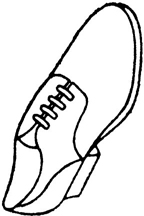
Figure 1 – Balmoral
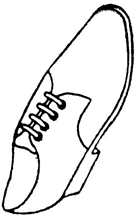
Figure 2 – Bluncher/Derby
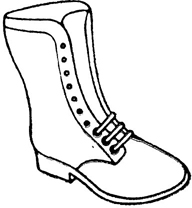
Figure 3 – Boot
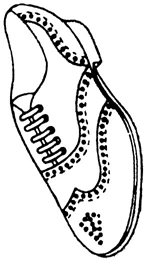
Figure 4 – Brogue

Figure 5 – D’orsay
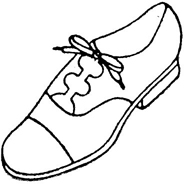
Figure 6 – Ghelic
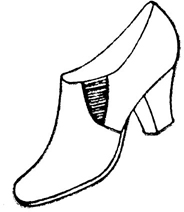
Figure 7 – Gore

Figure 8 – Jodhpur
68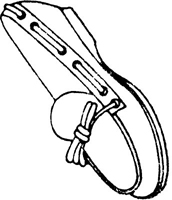
Figure 9 – Moccasin or Casual
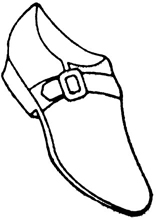
Figure 10 – Monk
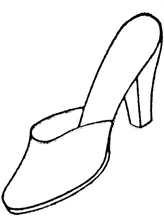
Figure 11 – Mule
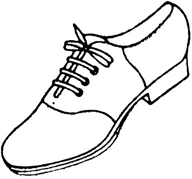
Figure 12 – Oxford
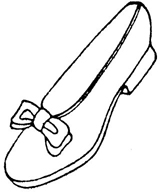
Figure 13 – Pump
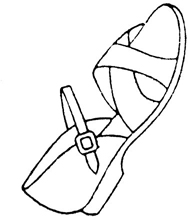
Figure 14 – Sandal

Figure 15 – Fringe/Shawl

Figure 16 – Strap
69
FIG. 17 LEATHER SAFETY BOOTS WITH LEATHER SOLE

FIG. 18 LEATHER SAFETY SHOES WITH LEATHER SOLE
70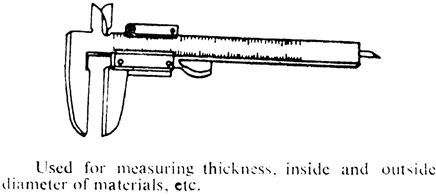
FIG. 19 MICROMETER
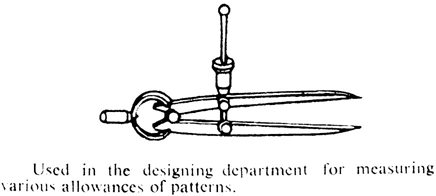
FIG. 20 SPRING DIVIDERS

FIG. 21 MEASURING TAPE
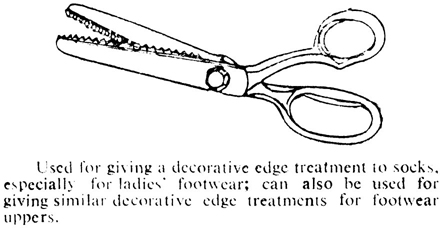
FIG. 22 INDENTING SCISSORS
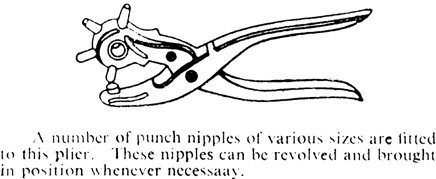
FIG. 23 REVOLVING PUNCH

FIG. 24 FUDGE WHEEL

FIG. 25 STITCH MARKER

FIG. 26 SEAT WHEELING TOOL

FIG. 27 STITCH SEPERATING WHEEL
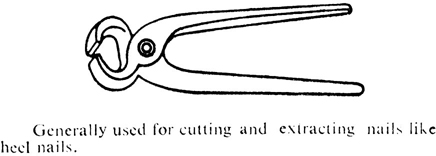
FIG. 28 CUTTING NIPPERS

FIG. 29 MANCHESTER NIPPERS
71
FIG. 30 SLEEKING STICK

FIG. 31 NAIL PULLER
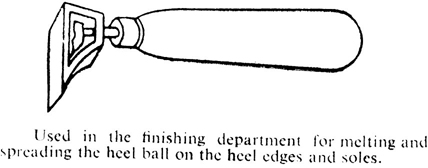
FIG. 32 HEEL IRON

FIG. 33 EDGE SETTING IRON

FIG. 34 WELT KNIFE

FIG. 35 STITCH SEPERATING TOOL
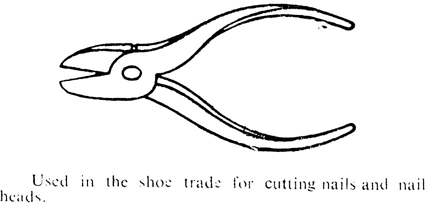
FIG. 36 CUTTING PLIERS

FIG. 37 CHANNELING TOOL

FIG. 38 CHANNEL OPENER

FIG. 39 PARING KNIFE

FIG. 40 SCISSORS
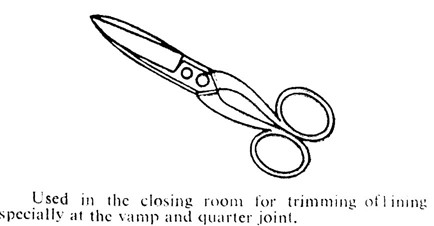
FIG. 41 BENT SCISSORS
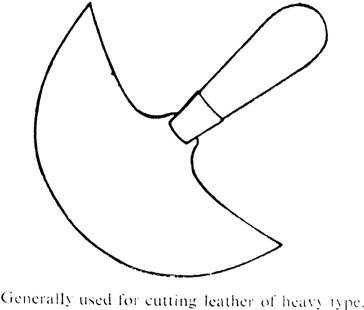
FIG. 42 CUTTING KNIFE
72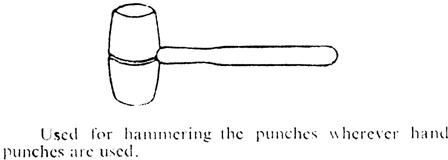
FIG. 43 WOODEN MALLET (RUBBERIZED)

FIG. 44 CLICKING KNIFE

FIG. 45 SHARPENING STONE WITH HANDLE

FIG. 46 SHARPENING STONE (RECTANGULAR TYPE)
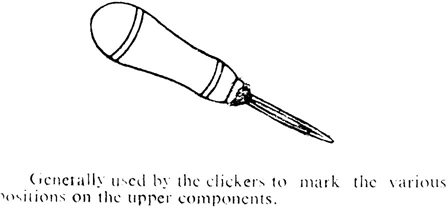
FIG. 47 PRICKING AWL
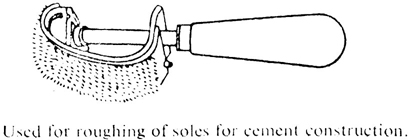
FIG. 48 ROUGHING TOOL
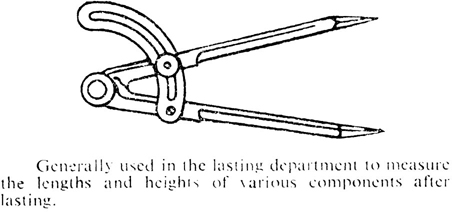
FIG. 49 ADJUSTABLE WING COMPASS

FIG. 50 HEEL SEAT TRIMMING KNIFE

FIG. 51 FOLDING HAMMER
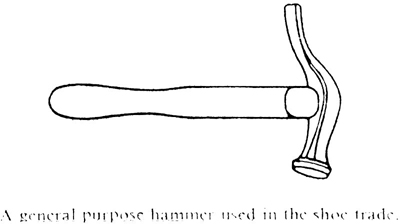
FIG. 52 SHOE HAMMER
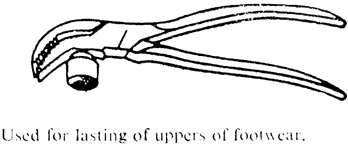
FIG. 53 LASTING PINCERS (HEAVY TYPE)

FIG. 54 LASTING PINCERS (MEDIUM TYPE)
73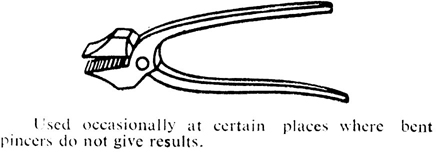
FIG. 55 LASTING PINCERS (STRAIGHT TYPE)

FIG. 56 NAIL PULLER (COMB TYPE HEAVY DUTY)

FIG. 57 NAIL PULLER (LIGHT TYPE)

FIG. 58 SHOE KNIFE

FIG. 59 MCKAY KNIFE

FIG. 60 VELDTSCHOEN LASTING PINCERS
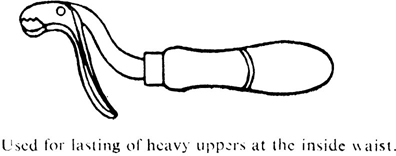
FIG. 61 BULLDOG PINCERS
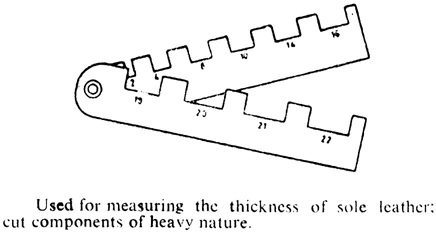
FIG. 62 THICKNESS GAUGE (SLOTTED TYPE)

FIG. 63 THICKNESS GAUGE (V TYPE)
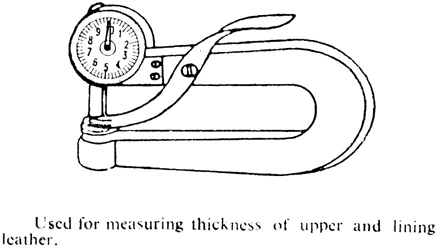
FIG. 64 LEATHER THICKNESS MEASURING GAUGE
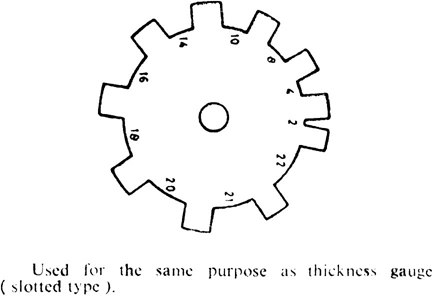
FIG. 65 THICKNESS GAUGE (CIRCULAR SLOTTED TYPE)
74 75 76 77